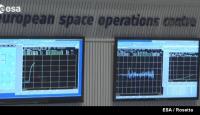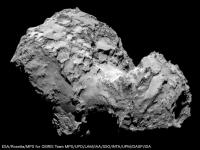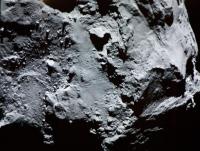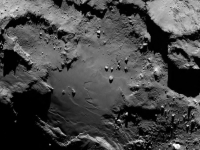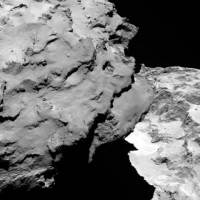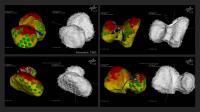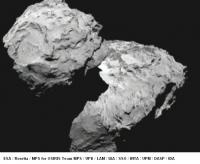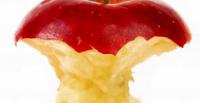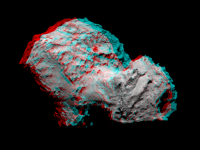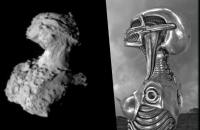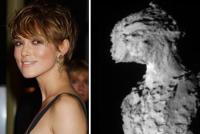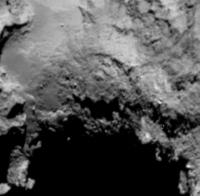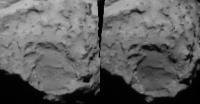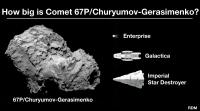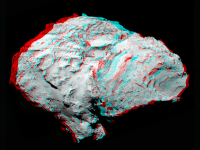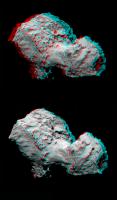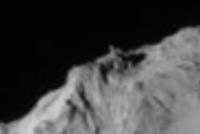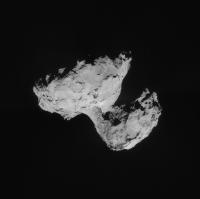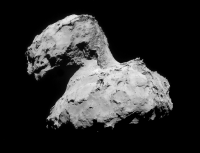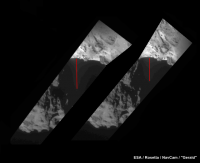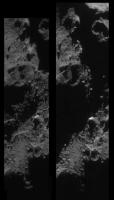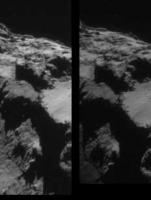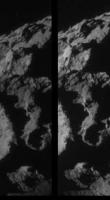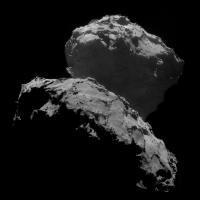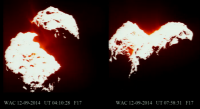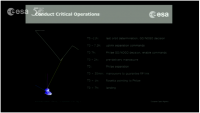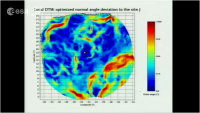Printable Version of Topic
Click here to view this topic in its original format
Unmanned Spaceflight.com _ Rosetta _ Rosetta - Early Orbital Operations at Comet 67P C-G
Posted by: Astro0 Aug 6 2014, 09:29 AM
Cheers at the European Space Operations Centre.
Well done!
Rosetta has arrived ![]()
Time for science!!!!!!!
Posted by: kenny Aug 6 2014, 09:59 AM
They are saying Rosetta is now in a heliocentric orbit matching the comet's, on the sunward side, and will continue to move along at 100km distance without orbiting
the comet for some time yet. Being closer to the sun its orbital velocity is naturally somewhat greater, and it slowly gains ground moving ahead of the comet.
Every 4 days or so they brake and fall back behind the comet, then catch up again, describing a triangular path which maintains the 100km distance.
Looking forward to some new pictures...
Posted by: mcgyver Aug 6 2014, 10:18 AM
http://blog.vitotechnology.com/wp-content/uploads/2014/08/173455_original.gif
http://blog.vitotechnology.com/?p=7165
http://www.esa.int/var/esa/storage/images/esa_multimedia/images/2014/08/navcam_animation_6_august/14705553-1-eng-GB/NavCam_animation_6_August.gif
http://www.esa.int/spaceinimages/Images/2014/08/NavCam_animation_6_August
MOD: Replaced (awesome) large in line GIFs with links
Posted by: mcgyver Aug 6 2014, 10:20 AM
Is the rotation period known?
Or where can I find images with original timestamps?
Posted by: anticitizen2 Aug 6 2014, 10:30 AM
I was putting together a final approach animation - but there are a lot of unreleased NavCam images..
So I slowed down the final 5 frames of their animation to allow a better look
http://i.imgur.com/LiPmKB1.gif
EDIT: My 1 image per day approach version : http://i.imgur.com/VuYZN78.gif
Posted by: belleraphon1 Aug 6 2014, 10:48 AM
What a bizzare shape! Awesome!
Well done ROSETTA team.... and thank you for taking us along!
Craig
Posted by: elakdawalla Aug 6 2014, 11:31 AM
http://planetary.s3.amazonaws.com/assets/images/9-small-bodies/2014/20140806_NavCam_animation_6_August_selection_stack.png
(Click to enlarge.)
Need to clean up the artifacts, but I'm too tired now...
Posted by: elakdawalla Aug 6 2014, 11:33 AM
https://www.youtube.com/watch?v=CNGu7KbXzOs (Youtube)
There's a coordinate system and poles marked on that animation, too.
Posted by: Explorer1 Aug 6 2014, 11:43 AM
New OSIRIS stuff in a few hours, according to the PI.
A 2D map of C-G seems like a tough order; the projection math alone... ![]()
Posted by: nprev Aug 6 2014, 12:04 PM
What a moment in history.
And big shout-out to Astro0 for the terrific Forum banner celebrating this event! ![]()
Posted by: 0101Morpheus Aug 6 2014, 12:48 PM
![]() Indeed
Indeed
There is an incredible amount variable terrain for such a small object. Could sublimation be the cause or is it something else? ![]()
Posted by: centsworth_II Aug 6 2014, 12:56 PM
In the press briefing it was noted that the blue represents constant shadow, the red constant light and the yellow shows areas with dark and light periods. Also from the briefing, they want the landing area 'to have a clear day/night cycle for scientific reasons.'
Screen shots from the video linked by Emily in http://www.unmannedspaceflight.com/index.php?s=&showtopic=7872&view=findpost&p=211744
Posted by: Gerald Aug 6 2014, 12:57 PM
Overview image of the imges posted by Astro0,
and two images showing the zone of major dust/volatile release:
Posted by: mcgyver Aug 6 2014, 01:03 PM
How to figure out scale in these wonderful images?
Posted by: Jaro_in_Montreal Aug 6 2014, 01:07 PM
There is an incredible amount variable terrain for such a small object. Could sublimation be the cause or is it something else?
Just a guess..... but it looks to me like the smaller component's shape, resembling half of an apple core, is the result of large amounts of material spalling off during the initial collision that formed this bizarre comet nucleus, leaving just a conical central part at the contact point - which subsequently filled in a bit with dust & debris.....
Posted by: anticitizen2 Aug 6 2014, 01:09 PM
Re-posting this very useful image by walfy of the comet on July 29th
The Burj Khalifa is about 830m tall if that works as a celestial kilometer-stick

Posted by: john_s Aug 6 2014, 01:11 PM
Wow. And spooky! This was designed by Tim Burton (or maybe Terry Gilliam)
John
Posted by: centsworth_II Aug 6 2014, 01:16 PM
Posted by: tolis Aug 6 2014, 01:32 PM
and two images showing the zone of major dust/volatile release:
Volatiles seem to be emitted primarily from the "neck". Is this similar to what was observed at Hartley 2 I wonder?
Posted by: Phil Stooke Aug 6 2014, 01:51 PM
No, it's the opposite of Hartley 2.
Phil
Posted by: centsworth_II Aug 6 2014, 02:07 PM
Maybe the neck jets represent the sublimation of superficial ice that collected in cold sinks at the end of the comet's last pass rather than indicating a deep structure of ice in the neck.
Posted by: Gerald Aug 6 2014, 02:33 PM
Here is a magnified "low"-resolution version of one of today's OSIRIS images (via screenshot), with a high-resolution patch of the "neck":
http://imgur.com/MWDPVTy
Posted by: DFinfrock Aug 6 2014, 03:38 PM
Screen shots from the video linked by Emily in http://www.unmannedspaceflight.com/index.php?s=&showtopic=7872&view=findpost&p=211744
If there are no significant engineering or safety constraints, I hope that the landing site selection committee avoids the areas at the end of either lobe of the comet. There you would have a great view of the local surface and dark space above. But if they can safely land in one of those green spots closer to the neck of the comet, just imagine the spectacular view - not only of the local surface, but of the other half of the comet looming overhead.
Posted by: machi Aug 6 2014, 04:07 PM
Stereo image of the 67P/Churyumov-Gerasimenko. One image is http://www.esa.int/spaceinimages/Images/2014/08/Comet_on_3_August_2014 (date 3.8.2014).
Second one is synthetic image obtained from OSIRIS and NavCam images. Resolution is 5.3 m/pix.
Credit for original images: ESA/Rosetta/MPS for OSIRIS Team MPS/UPD/LAM/IAA/SSO/INTA/UPM/.DASP/IDA/NavCam.
Posted by: akuo Aug 6 2014, 04:37 PM
Wonderful achievement to be here after so many years! Congrats to ESA.
To me the surface looks like snow banks shaped after a fierce storm.
Posted by: The Singing Badger Aug 6 2014, 04:53 PM
Here's a cool size comparison with London from the BBC:
http://news.bbcimg.co.uk/media/images/76758000/jpg/_76758586_rosetta_comet_624.jpg
Posted by: bobik Aug 6 2014, 05:08 PM
The cameras of Philae are pointed at the ground, thus - if all goes well - we would not be able to see the grandiose scenery overhead.
Posted by: Explorer1 Aug 6 2014, 05:30 PM
Some are pointed at the ground, but others are horizontal, Huygens style.
See https://www.youtube.com/watch?v=k1IFU6kxcD8
Posted by: charborob Aug 6 2014, 05:43 PM
See https://www.youtube.com/watch?v=k1IFU6kxcD8
Description of Çiva (Comet nucleus Infrared and Visible Analyzer) http://nssdc.gsfc.nasa.gov/nmc/experimentDisplay.do?id=PHILAE%20%20%20-01
Posted by: ollopa Aug 6 2014, 06:05 PM
I can't agree with the BBC graphic. The base unit is 4x2 km, while their graphic conflates the head into the scene. I am at Frankfurt Airport, so can't cut and paste. But Hal Weaver's Slide 51 refers. I have been at every Voyager encounter and more besides. This rocks!
Posted by: Adam Hurcewicz Aug 6 2014, 06:14 PM
This is fantastic 3D picture! Great work! I love it.
Posted by: testguru Aug 6 2014, 06:15 PM
I have not seen much discussion on the probability that a stray particle emitted from the Comet could damage either the orbiter or lander.
Are there any papers or information on this possibility? As the Comet continues to increase activity as it approaches perihelion I would think the probability of this happening will go up.
I assume they will try to avoid the areas on the Comet with active venting for both the Orbiter and Lander although the Orbiter probably can't stay away from the active areas all the time,
and the active areas should evolve with time as we approach perihelion.
Posted by: machi Aug 6 2014, 07:21 PM
You're welcome!
Posted by: marsbug Aug 6 2014, 07:33 PM
Do the zones of most emission roughly coincide with those that receive the least sunlight?
Posted by: Phil Stooke Aug 6 2014, 08:54 PM
Well... yes, I think it probably is!
Phil
Posted by: Mercure Aug 6 2014, 09:12 PM
Sublime cross-eye, thank you machi! Is this the most topographically bizarre heavenly body yet viewed in close-up?
Posted by: algorithm Aug 6 2014, 09:12 PM
Phil
Phew!!
Posted by: algorithm Aug 6 2014, 09:44 PM
I think Mr Giger would prefer more protruberences, although the lobe would appeal.
Posted by: Phil Stooke Aug 6 2014, 10:40 PM
OK, how can I stay out of this? I see something more like this. Possibly a great-grandparent?
Phil
Posted by: Astro0 Aug 7 2014, 12:41 AM
NOTE TO SELF:
Post one more pareidolia image and then berate yourself as an admin for doing so. ![]()
I think Rosetta and Philae need to watch out for Mr Chompy here. ![]()
ADMIN NOTE: I think we can dispense with the pareidolia comparison images now.
Posted by: lunaitesrock Aug 7 2014, 01:24 AM
Long time lurker here jumping into the discussion of this strange object.
I agree and have thought for several days now that 67P/C-G just didn't look right to be a contact binary. Looking at several of the recent highest resolution images, there are large-scale features in the 'neck' area which appear to be somewhat contiguous from the 'head' to the 'body'. These appear to exhibit similar types of features and textures as is seen in both lobes i.e. https://pbs.twimg.com/media/BuWJaVSIcAAVgZ9.jpg:large
I think a contact binary resulting from a low-speed impact of 2 bodies and subsequent gap infilling with loose material may not likely exhibit features like those seen... somewhat linear and contiguous higher density erosion resistant features and surfaces.
Jets of dust in the long exposure image seem to be emanating primarily from the neck area; likely from the higher albedo areas. If the neck resulted from increased ablation rates in this area of an assumed initial single somewhat spherical cometary body, quite a bit of material has been lost compared to the 2 lobes. On the other hand, 103P/Hartley and 19/P Borrelly, both of which had a bowling pin shape had jets emanating primarily from the lobes.
Posted by: lunaitesrock Aug 7 2014, 01:31 AM
The 3D image is absolutely incredible! I hope that models are eventually made for educational purposes. Would be cool to have on a desk stand.
Even cooler would be a mobile of all spacecraft-visited comets.
http://www.unmannedspaceflight.com/index.php?act=attach&type=post&id=33441
Posted by: Decepticon Aug 7 2014, 02:42 AM
What a strange object.
Reminds me of a broken Wasp Nest.
Posted by: djellison Aug 7 2014, 05:09 AM
Once shape-file data is out there, I'll certainly make a 3D printable STL file that people can get printed at Shapeways or other 3D printing sites.
I've already done Eros, Itokawa and Vesta ( and others )
http://nasa3d.arc.nasa.gov/search/ellison/model
Posted by: Phil Stooke Aug 7 2014, 05:30 AM
"On the other hand, 103P/Hartley and 19/P Borrelly, both of which had a bowling pin shape had jets emanating primarily from the lobes. "
Not Borrelly. Its main jets were from the central smooth area.
http://nmp.jpl.nasa.gov/ds1/img/borrelly_3.jpg
Phil
Posted by: bobik Aug 7 2014, 05:58 AM
See https://www.youtube.com/watch?v=k1IFU6kxcD8
ÇIVA-P cameras are inclined downward. You could see the local horizon, but if they "land in one of those green spots closer to the neck of the comet" you would not be able to see "the other half of the comet looming overhead".
Posted by: MichaelJWP Aug 7 2014, 06:42 AM
I've already done Eros, Itokawa and Vesta ( and others )
http://nasa3d.arc.nasa.gov/search/ellison/model
They look good, Doug. Do you provide textures and are the models u-v'd or are they just for printing?
I should say I don't often have the time to post here, mostly lurking, but this mission is amazing, living up to all the promise and more. I remember sticking it in the calendar back at the launch date telling myself not to get hopes up too high as there were so many risks to overcome, but kudos to everyone involved in this one.
- Michael
Posted by: Explorer1 Aug 7 2014, 06:55 AM
Yes, that's true. At best, it would just be a big cliff extending up beyond the edge of the frame.
But there will be that descent imaging, and I'm getting Huygens flashbacks...
Posted by: machi Aug 7 2014, 10:15 AM
Descent imaging by ROLIS is limited by onboard memory. So plan is that ROLIS will take few pictures after release from the orbiter, those will be immediately transfered to the orbiter and
then erased. FOV size is easy to find, because if you know distance, you now FOV size on comet. From distance 1000 meters FOV diameter is 1000 meters and resolution is ~1 meter.
Before touchdown ROLIS will take up to 8 images from maximum distance 25-50 meters (FOV 25-50 meters). Only few last images will be better in terms of resolution than
best possible images from OSIRIS camera.
CIVA has 60° FOV. Its cameras has FOV tilted down by 15° (25° for stereo camera) from the Philae's baseplate ("horizontal" plane). So it can see ~270 meters high peaks in distance 1000 meters (this of course depends on actual tilt of the lander).
Source: Space Science Reviews 128.
Posted by: jgoldader Aug 7 2014, 01:24 PM
I've already done Eros, Itokawa and Vesta ( and others )
http://nasa3d.arc.nasa.gov/search/ellison/model
Any chance of Gaspra? I did some work on that back before the Galileo flyby; it would be great to print it out.
Thanks!
Jeff
Posted by: lunaitesrock Aug 7 2014, 02:57 PM
New images are up:
http://blogs.esa.int/rosetta/2014/08/07/cometwatch-5-6-august/
Posted by: TheAnt Aug 7 2014, 04:13 PM
The http://blogs.esa.int/rosetta/2014/08/06/postcards-from-rosetta/ is what got my attention.
Posted by: mmatessa Aug 7 2014, 08:13 PM
ESA has the following graphic for the size of the whole comet:
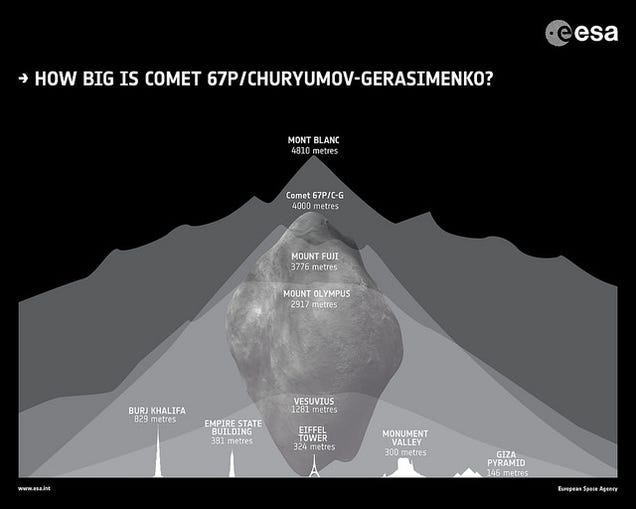
But it would be nice to see reference stadiums, buildings, or cars for the closer images.
Posted by: machi Aug 7 2014, 08:15 PM
BBC released very https://www.youtube.com/watch?v=WmPPRNxR2Kw from (evidently) OSIRIS camera. Images are from 3. August 2014.
Now it's possible to derive stereo images directly from the published images.
This is comparison with my "synthetic" stereo image of 67P (it's the lower pair).
You can see that top left image is exactly the same image as lower right image.
EDIT: This version was deleted and was replaced by http://www.unmannedspaceflight.com/index.php?showtopic=7872&view=findpost&p=211849.
Posted by: atomoid Aug 7 2014, 09:08 PM
heres a <sloppy> crosseye of the topography inside that shadowed 'hole' area inside the pole of the smaller clump at right in machi's stereo, this based on the sequence Emily http://www.unmannedspaceflight.com/index.php?s=&showtopic=7872&view=findpost&p=211743 earlier
Posted by: algorithm Aug 7 2014, 09:20 PM
What is the estimated mass of this object?
What is the mass of the lander?
Depending on the above, the gravitational pull on the lander may be negligable, so it could be.. pick a spot-any spot.
Posted by: Phil Stooke Aug 7 2014, 09:33 PM
It's more about local geology and safety. How smooth is the area? Is it coarse-grained or fine-grained, or maybe quite solid? (from thermal inertia). Is there any evidence of volatiles, or is it depleted, baked dry? Is the area active during the run-up to landing, or is it inert?
Phil
Posted by: centsworth_II Aug 7 2014, 10:16 PM
My estimate of how football stadiums at two locations would look.
Posted by: fredk Aug 7 2014, 10:36 PM
You should find slightly better image quality from the original BBC story here:
http://www.bbc.co.uk/news/science-environment-28659783
Posted by: machi Aug 7 2014, 11:18 PM
Yes, I should.
I saw that article but I have disabled automatic playback for flash so I overlooked this video and Google found the other one.
BTW, here is http://www.astronomicon.eu/wp-content/uploads/2014/08/rosetta-comet-67p-orbit-525.gif.
Posted by: anticitizen2 Aug 8 2014, 12:02 AM
I had to grab larger frames from the video and slow it down
http://i.imgur.com/T8oZl7a.gif
Two days of utter amazement so far
Edit: album of the screen captures: http://imgur.com/a/0Lo1E#0
Posted by: djellison Aug 8 2014, 12:27 AM
Nope - just un-textured STL's for printing.
I'll look into it - but it would be pretty low res so might not be worth the effort.
Posted by: machi Aug 8 2014, 01:00 AM
http://i.imgur.com/T8oZl7a.gif
...
Thanks! It's impossible with my Internet connection to grab this video at full resolution.
Here is very interesting view on the head of the comet 67P from two grabbed images.
Credit for original images: ESA/Rosetta/MPS for OSIRIS Team MPS/UPD/LAM/IAA/SSO/INTA/UPM/DASP/IDA.
Posted by: machi Aug 8 2014, 01:13 AM
And here is comparison between stereo images with both real images (lower one) and with one synthetic image (top) in the pair.
Thanks to anticitizen2 both pairs have now same resolution but the lower pair is still somewhat blurred.
I deleted the older version.
Posted by: anticitizen2 Aug 8 2014, 02:18 AM
And thank you for the 3D images! Those have truly brought me there next to the comet.
I feel like I owe you a dozen gasps of amazement from the people around me as I showed them your image of the comet in 3D
Posted by: lunaitesrock Aug 8 2014, 03:16 AM
The processed photos released to date all have good contrast and likely have been brightened and stretched to some extent. Have any been processed to show the comet's actual appearance?
I haven't seen much discussion on albedo except mention that 67P/C-G is very dark, as would be expected if much of the nonvolatile remnants on the surface are similar in composition to carbonaceous chondrite meteorites.
Karl
Posted by: nprev Aug 8 2014, 05:39 AM
INCREDIBLE, Daniel--thank you!!!!
In my opinion this is by far the most classically 'alien'-looking little world examined by spacecraft to date--straight out of a 1950s B-movie. Amazing to think of how different the processes by which all these odd, jagged landforms arose must be from those we've observed elsewhere. With any luck, though, we'll be able to see those processes in action a bit.
Posted by: tolis Aug 8 2014, 06:27 AM
The smaller lobe (the one with the ``hole'') reminds me of the front part
of a Klingon Bird of Prey.
Posted by: MichaelJWP Aug 8 2014, 06:42 AM
Thanks, C-G nowhere near as big as the Death Star then:)
Posted by: lunaitesrock Aug 8 2014, 08:45 AM
'Standing' in the neck area one would see the landscape curve to nearly vertical on both sides while rapidly dropping off on the other 2 sides. In some areas adjacent to the neck the landscape would curve to be nearly overhead (like in a rotating donut-shaped space habitat). What a strange place!
Posted by: bobik Aug 8 2014, 08:54 AM
http://img3.wikia.nocookie.net/__cb20120914100648/memoryalpha/en/images/e/e6/Ralph_McQuarrie_asteroid_spacedock_concept.jpg
Posted by: centsworth_II Aug 8 2014, 10:23 AM
Posted by: 0101Morpheus Aug 8 2014, 11:58 AM
It's for the best, I tend to think that our minds don't know how to handle objects with very high albedos. The moon looks bright enough to us but its albedo is only 12%!
Plus the camera would get saturated.
Posted by: Nebulium Aug 8 2014, 01:47 PM
Hello ![]()
First, think to Adelson's chessboard :
http://web.mit.edu/persci/people/adelson/checkershadow_illusion.html
As an example of "true" Moon rendition, using a small compact camera I shot a piece of wood charcoal (its albedo is similar to the Moon one) under Sun light in automatic mode :
Light measurement was "spot" on background, on left and center, the background is a 18% grey chart, on right, it is current black paper.
- Center is the standard result automatically optimized by the camera : the dark subject was slightly enlighted
- Left was shot with asked 1IL underexposure, in order to obtain the official value of 128 for the background.
- Right is the standard result automatically optimized by the camera : the dark subject was more enlighted, as well as the background.
For me, the most realistic rendition is on left. But on right it shows more shades and details...
PS : Note that the light rendition curve of the compact camera is far from linear and probably histogram adaptative, while scientific cameras are nativly linear...
Posted by: Gerald Aug 8 2014, 11:36 PM
So very roughly - it's doing 1km/hr or 0.28m/sec. V^2/r is thus 0.000039 m/sec^2
Surface gravity is approximated as 10^-3 m/sec^2 3 orders of magnitude higher than the centripetal acceleration due to rotation.
Hmm, according to the http://en.wikipedia.org/wiki/67P/Churyumov%E2%80%93Gerasimenko, the escape velocity is estimated to 0.46 m/s, corresponding to about 0.33 m/s for a circular orbit.
So I'd say within the current uncertainty, respecting the rotation, the resulting surface gravity at the parts most distant to the center of mass is about zero.
A significantly more compact body with the same angular momentum would be torn apart.
This opens a scenario almost opposing the contact binary approach, meaning head and body could have been broken apart already by centrifugal pseudo-force, and kept together by the stretched "neck", which would give the "rubber" duck metaphor more sense than originally anticipated.
This way the inner of the comet would be exposed at the neck.
Additional momentum could have been provided by impacts or by http://en.wikipedia.org/wiki/Yarkovsky%E2%80%93O%27Keefe%E2%80%93Radzievskii%E2%80%93Paddack_effect.
Posted by: lunaitesrock Aug 9 2014, 03:25 AM
This photo from the end of the large lobe is particularly interesting to me especially when viewed under magnification...
http://blogs.esa.int/rosetta/files/2014/08/Comet_details_node_full_image_2.png
At 6 o'clock there seems to be layering where bright (icy?) layers show through the mantle of darker material... I count about 6 'steps' climbing to the tall white cliff to the lower left.
At 9 o'clock just to left of center there are boulders which are covered in a mantle of the darker material.
Also at 9 o'clock to the left of those boulders the mantle of darker material seems to have flowed? over rougher surface features, draping the underlying terrain.
At 10 o'clock in the basin there are striations which look to me like some sort of lobate flow/collapse features... perhaps gravel fluidized by sublimation of icy materials underneath. They lead away from the bright cliffs on the left.
At about 12 o'clock immediately to the lower left of the large bright boulder there is a small area of evenly spaced striations which may have flowed from a collapse to the upper right.
The large smooth area in the center with the small linear features (ice layer?) I suspect is not a dust layer but a layer of gravel as was seen on Itokawa in the Muses Sea. I think most of the fine dust would escape with the outgassing of the comet.
I can't wait for higher resolution photos to come down. The geology of this object is so varied. I would bet that the processes which formed all features of the comet and the comet itself will be unraveled over the next few years.
Posted by: MarsInMyLifetime Aug 9 2014, 04:42 AM
http://blogs.esa.int/rosetta/files/2014/08/Comet_details_node_full_image_2.png
I wonder whether these "boulders" may be ice features not unlike fumarole "smokers" in Earth's deep underwaters, or http://strangesounds.org/2014/06/amazing-phenomena-photos-of-5-incredible-natural-phenomena-around-the-world.html/fumaroles-or-snow-chimney. Near the middle top of that image you linked, one object appears to have a hook-shaped shadow, and in the bottom right quarter is what appears to be a cylindrical tower that casts a notably long shadow, almost like the overhead images of Mars dust devils. http://epoxi.umd.edu/3gallery/graphics/enc_briefing/Sunshine1.png seemed to have these as well. Yes, more closer!
[Edit: not Borrelly but Hartley. Thanks, Phil!]
Posted by: TheAnt Aug 9 2014, 07:19 AM
Phil
I would rather compare it to the work of the meteorologists, with a situation changing by the day or week. =)
@MarsInMyLifetime: I think you're on the spot there! =)
Posted by: machi Aug 9 2014, 10:14 AM
I found multiple articles where authors use known cometary rotation periods for determination of limits for shapes and density.
Very interesting is fig.15. in http://arxiv.org/pdf/astro-ph/0610301v1 by C. Snodgrass, S. C. Lowry and A. Fitzsimmons.
In my opinion this is by far the most classically 'alien'-looking little world examined by spacecraft to date--straight out of a 1950s B-movie. Amazing to think of how different the processes by which all these odd, jagged landforms arose must be from those we've observed elsewhere. With any luck, though, we'll be able to see those processes in action a bit.
Yes, this is beautiful crazy comet. From all comets observed from spacecrafts I think that this one is the best for detailed investigations.
I hoped that 67P will be similar to the Wild 2 and it's actually even more crazy than "too wild Wild 2"!
Posted by: mcgyver Aug 9 2014, 10:26 AM
Parallel-eyes images can be directly seen in 3d-enabled TV sets just at a click of a button on the remote control.
Posted by: mcgyver Aug 9 2014, 03:10 PM
In which way "syntethic"?!?
Posted by: machi Aug 9 2014, 04:25 PM
It's image which is combination of two images. It can be obtained by warping to another image or reprojection to another image.
I haven't automatic software for this so I did this manually in Sqirlz Morph.
I gave example of this http://www.unmannedspaceflight.com/index.php?showtopic=7835&view=findpost&p=211663.
This process is time consuming and its quality is dependent on the author (as it's not automatic) but it's usable when other methods are unreachable.
Posted by: scalbers Aug 9 2014, 07:53 PM
Yes the pointed shadows and hook shape are pretty fanciful. Sounds like a nice candidate landing site, except the green dots on their landing site map aren't that close by. Maybe there are other "chimneys" that coincide with the green landing dot candidates. These would be ones in the yellow region of the map with alternating light/dark periods of sunlight.
Any chimneys that would also be in view of the active neck area would be an added bonus.
On the other hand, a landing site might have to be smooth enough to be safe, depending on their navigation accuracy.
Posted by: Phil Stooke Aug 9 2014, 08:03 PM
Those pics were of Hartley, not Borrelly.
Phil
Posted by: lunaitesrock Aug 9 2014, 09:25 PM
Closer and closer. 81 km now.
http://blogs.esa.int/rosetta/2014/08/09/cometwatch-8-august/
Posted by: brellis Aug 9 2014, 10:17 PM
Is the lander still asleep? If so, will it be powered up only after touchdown? Searching the web, I've learned there are batteries that can/will be used after touchdown and recharged once the solar panels are unfurled - but I'm curious to know if we are aware of the status of its instruments and batteries at this point. Thanks!
Posted by: machi Aug 9 2014, 10:24 PM
Lander is awake from February or March. All instruments and batteries are fine (you can find articles about it on http://blogs.esa.int/rosetta/).
It has two different batteries. Non-rechargeable for high priority science after landing and rechargeable for long term operations.
Posted by: fredk Aug 9 2014, 11:13 PM
I think the hook is an illusion: I see the lower "hook" part of the shadow as the shadow of a second, smaller boulder immediately below the larger one. And the long shadows towards the bottom of the frame seem to be the result of a very low illumination angle.
That's not to say that this isn't an insanely cool place!
Posted by: bobik Aug 10 2014, 07:48 AM
Go to the http://www.musc.dlr.de/philae/telemetrie.html - telemetry in (almost) real time.
Posted by: Explorer1 Aug 10 2014, 08:12 AM
From August to October 2014:
This might be a sign of images of the solar panels like the 2007 Mars flyby (the cameras have to be tested prior to landing anyway, right?).
Posted by: climber Aug 10 2014, 10:36 AM
From rosetta.jpl.nasa.gov... Couldn't copy paste the link which show a picture of the target by the COSISCOPE camera.
Now that comet 67P/Churyumov-Gerasimernko is within our reach, Rosetta's mass spectrometer COSIMA, managed by the Max Planck Institute for Solar System Research in Germany, is beginning to reach for cometary dust. Literally.
On Sunday 10 August 2014, COSIMA will expose its first of 24 targetholders aiming to collect single dust particles. This might take a while. After all, from dust particle modeling, 67P/C-G's coma is still comparable to a high-quality cleanroom. But, as 67P/C-G travels closer to the Sun along its orbit, the comet's activity will increase and more dust will be within reach. For now, we are planning to keep the target exposed for one month, but checking on a weekly basis if the model predictions are not too low and if we are lucky.
COSIMA's targets were developed and prepared by the Universität der Bundeswehr in Germany. Each of these targets measures one square centimetre. It consists of a gold plate covered by a 30 µm thick layer of "metal black" (gold in this case), which has a very low albedo due to its high porosity.
Tests in the laboratory have shown that this layer should decelerate and capture cometary dust particles impacting with velocities of ~100 m/s. The grazing incidence illumination by LED's combined with the very low albedo of the target will provide high contrast for collected cometary grains, in particular if they stick out of the "gold black" layer.
As a reference, an image of this target has been obtained before cometary dust exposure on 19 July 2014 by the COSISCOPE camera, COSIMA's built-in microscope which was developed by Institut d'Astrophysique Spatiale (CNRS/Université Paris Sud, France).
The image shows…. well, basically nothing. But that's the point. We will identify the dust grains we collect on the target's surface by comparison with this empty target. The COSISCOPE microscope will take new images every week from now onwards.
The grains we identify will then be analysed in mid-September, thus providing the first in-situ analysis of cometary grains with a high mass resolution. COSIMA uses the method of Secondary Ion Mass Spectrometry. This means that the dust particles are in for quite a ride! They will be fired at with a beam of Indium ions. This will spark individual ions (we say secondary ions) from their surfaces, which will then be analysed with COSIMA's mass spectrometer.
All in all, this will help us understand what material cometary dust is made of, and that is the major science goal of COSIMA.
Posted by: Nebulium Aug 10 2014, 11:26 AM
Hello ![]()
From :
http://rosetta.jpl.nasa.gov/news/cosima-reaches-dust
A picture of the target by the COSISCOPE camera :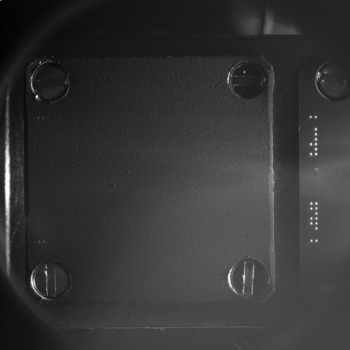
Credits: ESA/Rosetta/MPS for COSIMA Team MPS/CSNSM/UNIBW/TUORLA/IWF/IAS/ESA/BUW/MPE/LPC2E/LCM/FMI/UTU/LISA/UOFC/vH&S
Posted by: Gerald Aug 10 2014, 11:31 AM
From http://www.youtube.com/watch?v=Mf1zsACcXc4&feature=youtu.be, schedule until october:
Posted by: SpaceScout Aug 10 2014, 01:03 PM
That's tentalizing! Similar features were seen on Wild 2 and interpreted as possible erosion-resistant fumaroles. Check out Figure 6 in http://astrochemistry.org/docs/Brownlee%20%282004%29-Science.pdf. With the resolution of OSIRIS I would expect to see summit pit on these pinnacles.
Also, 67P seems to have a lot of structural features, such as parallel linear ridges and scarps that, if I remember correctly, were rarely seen on previous comets. These structures characterize both the head and the body and might be primary structures, supporting the idea that head and body are genetically related, i.e., they formed on an originally single object.
Greetings to all
Posted by: machi Aug 10 2014, 03:28 PM
Monster!!
This is 180° rotated version of yesterday's http://blogs.esa.int/rosetta/2014/08/10/cometwatch-9-august/.
Credit: ESA/Rosetta/NavCam.
Posted by: Gerald Aug 10 2014, 03:46 PM
... bleeding at its neck out of a deep wound?
Posted by: Harder Aug 10 2014, 05:20 PM
Monster? Duck?? Myself, I thought I saw a lion head one day. But whatever the "view of the day", depending on sun angle and/or one's imagination, sooner or later order needs to be created out of the chaos that this irregularly shaped comet presents to the scientific world. I asked via the ESA Rosetta blog whether they would decide on a cartography system at the start of the mapping phase (10th Sept) but no answer (yet).
Googling, I found a most telling statement about this interesting subject. Quote: "cartographic options for non-spherical worlds have until recently been very limited"
See http://adsabs.harvard.edu/full/1992acm..proc..583S
The author?? Our one-and-only Philip J. Stooke!
Posted by: wildespace Aug 11 2014, 04:48 AM
Are there any plans to take RGB images of the comet with OSIRIS? (I'd love to see an overal true-colour image of the comet, before Rosetta starts mapping the surface close-up)
Also, I can't find any information or specifications about the NAVCAM, which has been giving us these amazing images of the comet so far. Is it an unfiltered camera? What is its wavelength sensitivity?
Posted by: Harder Aug 11 2014, 07:31 AM
The Rosetta blog works! A follow-up post provided a link to an animation by DLR, the national aeronautics and space research centre of the Federal Republic of Germany, regarding possible landing sites on 67P - including a polar and coordinate system overlay on 67P.
See http://youtu.be/CNGu7KbXzOs
Posted by: Gerald Aug 11 2014, 11:00 AM
OSIRIS has lots of "color" filters (for NAC: far uv, near uv, blue, green, orange, hydra, red, ortho, near ir, Fe2O3, IR), see http://www.lpi.usra.edu/sbag/meetings/jul2014/presentations/0245_Tue_Weaver_Rosetta.pdf, p.15. So they could.
As I understood, they've at least taken a green image (press conference august 6), already, and color images from a distance (status update p.20).
Taking color spectra and looking for color variations are science objectives (status update, p.21).
Posted by: fredk Aug 11 2014, 04:12 PM
Some specs http://starbrite.jpl.nasa.gov/pds/viewInstrumentProfile.jsp?INSTRUMENT_ID=NAVCAM&INSTRUMENT_HOST_ID=RO, although nothing about filtering.
I didn't notice anything in the special volume of Space Science Reviews (128) about navcam - maybe someone else did?
Posted by: JRehling Aug 11 2014, 05:54 PM
I'm curious about how solar illumination varies throughout the cometary "year" and if that would explain a history of erosion that might have formed the neck from an initially more spherical ("more", not "extremely") body.
Alternately, I think about Iapetus and even Callisto as analogues and wonder what happens to the non-icy material when outgassing takes place. Does some of that non-icy material settle elsewhere on the comet, or does it effectively depart into space? If it deposits onto non-outgassing locales, there could be a positive feedback loop of some areas having too much non-icy material in the regolith to outgas, while other areas have accelerated outgassing.
I guess we'll know when Rosetta's finished its mission.
Posted by: marsbug Aug 11 2014, 05:57 PM
That's not to say that this isn't an insanely cool place!
There may not be any unambiguous vents (yet!) but looking at http://www.esa.int/spaceinimages/Images/2014/08/Comet_activity_on_2_August_2014 I can see three, maybe four, distinct plumes. They all seem to come from sources distinct but near to each other, which might imply a more vent like outgassing than generalised sublimation
Posted by: scalbers Aug 11 2014, 09:19 PM
Here's a recent light curve of C-G as seen from Earth (at bottom), so we can get a rough idea of the projected activity increase. Note some of the brightening would be from the viewing and solar illumination geometry, while some would be from more intrinsic activity.
http://aerith.net/comet/catalog/0067P/2015.html
Posted by: machi Aug 11 2014, 10:26 PM
NavCams are not filtered (they are two NavCam cameras).
Posted by: Gerald Aug 11 2014, 11:25 PM
After hipass filtering (30 pixels), and appropriate non-linear stretching, it looks to me like the four-plumes version (or more). Here a false-color version of the OSIRIS image, after rgb-channel-combining the original (red) with the processed image (green/blue) :
Posted by: SpaceScout Aug 12 2014, 10:59 AM
I guess the smooth and brigther areas on the comet are good candidate for landforms formed by deposit of non-icy material
Posted by: marsbug Aug 13 2014, 06:10 PM
I don't suppose there are any images with a regular exposure length taken near then time of the over-exposed one? It'd be intruigingn to narrow down which part of the neck the plumes are coming from, even just which side.
Posted by: lunaitesrock Aug 13 2014, 06:37 PM
You could come very close by comparing the silhouette in the original long exposure image below to corresponding silhouettes of short exposure images taken as the comet rotates.
http://www.esa.int/spaceinimages/Images/2014/08/Comet_activity_on_2_August_2014
Posted by: Gerald Aug 14 2014, 12:09 AM
That's a combined (registered, averaged, brightened and stretched before and after averaging) version of screenshots of this video of the http://www.esa.int/spaceinvideos/Videos/2014/08/Rosetta_at_comet_First_images_science_results, starting at about 1:27:20:
Posted by: marsbug Aug 14 2014, 06:22 AM
Thank you, I've been packing for a family holiday so time has been a bit short for me. Looking at that, and the larger images on the esa site, it seems the 'jets' roughly originate from an area of the bright white deposits which has a family of large boulder-like features scattered about. While I like the idea of 'smokers' the first thought I have is that the boulders are more heat absorbent, get the sun easier because they stick up, and the emission is caused by sublimation of material around their bases...
Posted by: Gerald Aug 14 2014, 08:15 AM
I've been thinking towards freshly exposed material with less dust cover, and higher abundance of volatiles, maybe as a consequence of exterior or interior mass wasting (a bit like tectonics). In the latter case there could have formed cracks, releasing volatiles.
Release of volatiles may remove more dust, and accelerate exposure of fresh interior material.
Reduction of net gravity (due to changing rotation) reducing the protective pressure of the dust layer might be a more remote possibility.
Posted by: Gerald Aug 14 2014, 01:27 PM
Just did a totally oversimplified model calculation, ignoring all attractive forces besides gravity:
No errors assumed, a roughly spherical dust particle of density 1 g/cm³, http://en.wikipedia.org/wiki/Thermodynamic_temperature http://blogs.esa.int/rosetta/2014/08/07/its-science-time-contd/, and a diameter of about 40 nm will immediately escape a body with an http://en.wikipedia.org/wiki/67P/Churyumov%E2%80%93Gerasimenko, as estimated for 67P/C-G, by its http://en.wikipedia.org/wiki/Brownian_motion allone.
(Setting translational kinetic energy E = 3/2 k_B T_k equal to E = 1/2 m v², with Bolzmann constant k_B, kinetic temperature T_k, mass m, escape velocity v.)
This might allow for a "dust atmosphere" of particles larger than about 40 nm diameter.
Electrostatic repulsion due to positive charging by http://en.wikipedia.org/wiki/Photoelectric_effect may add additional "pressure", and increase this minimum particle size.
Edit: Replaced 400 nm by 40 nm, one decimal digit.
Posted by: djellison Aug 14 2014, 01:39 PM
Brownish motion is the result of impacts upon a particle by the molecules of the fluid it's suspended in (i.e. dust floating in an an atmosphere or in suspension in a liquid of some sort)
How does that apply here?
Posted by: Gerald Aug 14 2014, 02:12 PM
We get the same kind of vibrations at surfaces or within a dust layer, if not cemented or bound otherwise. Dust particles (may?) take the role of molecules in a liquid or in a gas due to the very low gravity.
Edit: Think of dust as loosely bound macro-molecules.
Posted by: fredk Aug 14 2014, 02:41 PM
(Setting translational kinetic energy E = 3/2 k_B T_k equal to E = 1/2 m v²)
So you assumed all of the thermal energy was in the form of bulk kinetic energy of the dust particle? That's a pretty good approximation for very small molecules, but why should we ignore the internal thermal energy of a 40 nm particle?
Posted by: belleraphon1 Aug 14 2014, 02:55 PM
From ESA blog.. 667P/C-G in 3D
http://blogs.esa.int/rosetta/2014/08/14/comet-67pc-g-in-3d/
Posted by: xflare Aug 14 2014, 03:25 PM
WOW...!
and no obvious craters either.
Posted by: lunaitesrock Aug 14 2014, 03:56 PM
Wow ! The side of the upper lobe is covered in striations everywhere that is not covered by debris. Fractures from an ancient impact or layering from changing conditions during the formation of a much larger body? It looks like freshly broken rock, although the material and scale are vastly different.
The smooth area of fines in the top center seems to be draped over a cliff while that in the right center neck area is very sharply delineated from the clean fresh icy area. Can't wait to see all this in more detail.
Posted by: Gerald Aug 14 2014, 04:29 PM
That's a good point. Thus the size of particles escaping by Brownian motion should be (much?) smaller. Details (particularly vibrational modes) are rather tricky.
Posted by: SpaceScout Aug 14 2014, 04:41 PM
Normal to the possible "layering", there seems to be some "ridges". How did they formed...perhaps mass wasting in low-gravity environment?
Or are these erosion-resistant conduits seen in section?
Posted by: machi Aug 14 2014, 05:15 PM
I made cross-eye version from the amazing http://blogs.esa.int/rosetta/2014/08/14/comet-67pc-g-in-3d/.
It looks that StereoPhoto Maker can do slightly better job in its automatic alignment mode.
Credits for original images: ESA/Rosetta/MPS for OSIRIS Team MPS/UPD/LAM/IAA/SSO/INTA/UPM/DASP/IDA.
https://www.flickr.com/photos/109586958@N03/14895000876/
Posted by: Explorer1 Aug 14 2014, 05:16 PM
Amazing! Look's like the left side of the top lobe almost looks like it could crumble and slide down at a any time. Everything looks so fragile and soft (even that lone crater)
Today's navcam taken after another manoeuvre:
http://www.esa.int/spaceinimages/Images/2014/08/Comet_on_13_August_2014_-_NavCam
Posted by: marsbug Aug 14 2014, 07:11 PM
The boulders on the neck almost look wind carved in http://www.esa.int/var/esa/storage/images/esa_multimedia/images/2014/08/comet_on_7_august_a/14721226-1-eng-GB/Comet_on_7_August_a.jpg. Is it me or do they seem to be lined up, like the tips of ridges? A couple of them have protrusions near their peaks that are similar to wind carved formations I've seen in the Scottish highlands.
Posted by: marsbug Aug 14 2014, 07:27 PM
Release of volatiles may remove more dust, and accelerate exposure of fresh interior material.
Reduction of net gravity (due to changing rotation) reducing the protective pressure of the dust layer might be a more remote possibility.
Looking at the upper left hand quarter of the image I linked in my previous post I can see a couple of steep sided pits... could they have formed through a process like that?
Posted by: lunaitesrock Aug 14 2014, 09:03 PM
I wonder if the whitish area to the right of center is the source of the jets seen on the August 2 long exposure image.
It seems very clean with no traces of dust or debris and looks like it is subliming/eroding away and eating into the dust-covered surface, especially on the right side with all the non-volatile components being lifted away from this area.
Posted by: atomoid Aug 14 2014, 09:17 PM
as for craters, unless there is a better explanation i suspect many of the deep circular 'pockmarks' are actually very old craters from larger impacts having been evolved through sublimation and other erosional processes. perhaps newer and ostensibly more common small ones like Emily found appear classically clean because they don't persist very long but get averaged out by sublimation and settling? (or maybe deep space is just a very empty place and older ones date back 'billions and billions'). heres a crosseye of a section at top of a group of 3 possible crater relics. why would such crater walls persist? alternation and hardening due to impact melt?
Posted by: Gerald Aug 14 2014, 09:22 PM
Runaway outgassing for some period of time looks like a plausible cause for theses pits, probably not too recently - due to the debris fill.
But it's too early to rule out other options.
It could also have been a more virulent event.
...
This would be my first choice, too.
Posted by: Gerald Aug 14 2014, 09:52 PM
Resublimation / precipitation of water ice and organics could work (as cement for the dust/regolith).
Or just compactification, if the cause has been a virulent event (e.g. an explosive gas eruption).
Since the gravity is low, the walls don't need to be very strong.
Posted by: ngunn Aug 14 2014, 11:32 PM
To me it looks like the smaller lobe was originally attached to the long end of the bigger one, but then the neck broke and it rolled over to lie parallel. Maybe the cracking occurred at that time.
Posted by: walfy Aug 15 2014, 12:41 AM
An http://www.esa.int/spaceinimages/Images/2014/08/Rosetta_s_comet_in_3D of the comet from ESA.
I took the liberty of "improving" it, at least for my eyes, by adjusting the relative position of left and right channels. L and R images in the original tend to drift from sharing same horizontal plane in some regions, very uncomfortable for the eyes! I'm guessing the drifting is due to the vantage point of Rosetta not being directly above the comet's equator, where you would get perfect positioning for parallax as the bizarre object rotates. Here's a tweaked lower half of the released image:
...and the upper-half.
Posted by: atomoid Aug 15 2014, 01:19 AM
imho, the image currently foaming in my head is a surface dominated on most outfacing areas by overlapping ancient impact crater relics modified by sublimation and other types of erosion discussed here. the more recognizable crater relics remain remarkably deep and circular perhaps due to melting-imposed cohesion of the walls by cementation of a regolith/ice surface and steadily deepened by sublimation of an underlying material composed mostly of ice. but I haven't heard (nor have i been paying attention) of any official speculation about the density or composition of 67PCG at this point so its just ephemeral imaginings in the dearth of facts.. like this nice one with its high cemented walls in that view could have been formed by the walls persisting as the surrounding surface sublimates around them, finally becoming undermined and crumbling into boulders rolling downhill at what must be a comically slow pace.. (its interesting to note there do not appear to be any boulder tracks, if they could have enough 'weight' from the fall to leave any sort of impression in what seems at least by apparent smoothness to be a signifficantly deep dust field)
Posted by: tdemko Aug 15 2014, 01:54 AM
It looks to me like the internal structure of the comet as exposed in the valley wall is characterized by a fabric of vertical to radiating fractures. Most seem to radiate from the center of the mass, but others form shorter fan-like arrays. Maybe this structure reflects some original crystallization (mega-crystal faces) or a later re-crystallization or cooling fabric (columnar to prismatic jointing).
I hate to admit it, but they got it mostly right in the movie http://www.vfxhq.com/1998/armageddon_rock.html!
Posted by: lunaitesrock Aug 15 2014, 03:05 AM

The eroded crater (right side of the body) in today's ORISIS image is interesting in that it is looks to be very fragile and the shadow profile in the lower right of the crater has what looks somewhat like a balanced 'rock' as cropped above. Bright spot is the 'rock' at 9 o'clock and the top heavy shadow is at 3 o'clock.
I've seen mentioned before that there may be 'rocks' on pedestals as sublimation occurs around the base of insulated masses of ice (balanced rocks).
I think that when the resolution increases in low orbit a few weeks from now, several arches/holes with diameters of a few meters will be found in areas such as this with thin walls. They would likely be short-lived structures, perhaps lasting only 1 orbit of the sun or even just days near periapsis.

Posted by: Gerald Aug 15 2014, 11:33 AM
One of my first thoughts after looking to these structures has been the largest crystals of http://en.wikipedia.org/wiki/Needle_ice "ever".
(https://www.google.de/?gws_rd=ssl#q=ice+needles+minnesota as a supercool(ed) example.)
But the idea first appeared too weird to post.
Posted by: lunaitesrock Aug 15 2014, 11:37 PM
Interesting spire? from today's image release (8/14 image) Looks very monument valley like assuming it is actually a spire. Would love to see in 3D from 30 km orbit.
Posted by: TheAnt Aug 16 2014, 08:39 AM
I really wondered about that one too! A good use of the question mark there, lets wait and see for more clear images. If it really is one such feature they will likely wish to have a better look. =)
Posted by: MoreInput Aug 16 2014, 10:50 PM
Here a picture of all current images. I annotated some features I think I identified. Maybe I totally wrong, but this comet is really a strange one...
green: B means body, H means head
A: Deep black crater
B: crater
C: Line of bolders on the neck ("necklace")
D: tongue like feature
E: depression
F: Flat field with one side steep slope (cirque-like?)
G: elongated flat field
H: Crater field
I: Flat field
J: Pan cake like feature / crater
K: winding wall
L: great wall with fractures
M: Crater
N: tower montain
P: Deep Crater
O: Bay like feature
Posted by: walfy Aug 17 2014, 11:24 PM
After rotating a bit the leftward image, this interesting crater renders a little easier for the eyes, though http://www.esa.int/spaceinimages/Images/2014/08/Rosetta_s_comet_in_3D is still pretty awesome. I also sharpened it just a touch. The 17 minutes between the L and R shots shortened the shadows, so they throw off the 3D effect a bit in those areas. (My guess is that it was morning there when the shots were taken.) Anyway, this crater is pretty mind blowing, as well as the whole comet. A big thanks to ESA and the Rosetta team for all the updates!
Just one more from a different part of the comet, with a little processing to the image:
Posted by: walfy Aug 18 2014, 07:56 PM
Excellent video from ESA depicting orbital insertion of Rosetta:
https://www.youtube.com/watch?v=Mf1zsACcXc4
And accompanying blog post:
http://blogs.esa.int/rosetta/2014/08/18/whats-up-with-rosetta/
Posted by: tolis Aug 18 2014, 09:21 PM
The craggy rim of the large depression (crater?) at the centre is reminiscent of the Icy Spires of Callisto:
http://spaceflightnow.com/news/n0108/23callisto/
Posted by: ngunn Aug 18 2014, 10:00 PM
I tried it with the glasses the right way round and sure enough it is a great view, though as you say the shadows are a bit annoying. Then I tried swapping the specs around and, instead of seeing the topography reversed, much to my surprise I saw it looking just the same but with the shadows now helping rather than hindering the visualisation. I suppose the brain latches onto either the black shadows or the shading on small topographic details, whichever makes more sense. Whatever the explanation this is the first anaglyph I have ever seen that works with the glasses both ways round.
Posted by: pablogm1024 Aug 19 2014, 12:26 PM
green: B means body, H means head
A: Deep black crater
B: crater
C: Line of bolders on the neck ("necklace")
D: tongue like feature
E: depression
F: Flat field with one side steep slope (cirque-like?)
G: elongated flat field
H: Crater field
I: Flat field
J: Pan cake like feature / crater
K: winding wall
L: great wall with fractures
M: Crater
N: tower montain
P: Deep Crater
O: Bay like feature
Hi MoreInput,
This is an amazing achievement; I believe it can truly help others (like me) keep track of the different features.
However, I think that the features A, E and P are one and the same, just under different perspectives and illumination condition.
BTW, my favorite feature is N, but there are two of them.
Keep up the good work
Posted by: Gerald Aug 19 2014, 05:11 PM
The generated frames could be used to create a more "comfortable" anaglyph, or even an animation of the comet's rotation.
That's the result of a few days of programming and test running a frame interpolation algorithm, to get a very draft of what you suggested, at least:
http://imgur.com/jjAWqLN
There are still loads of issues, and about as many ideas to resolve them. But that takes more time; I've posted this draft, because I'm not sure, whether/when I can spend the necessary time. Hopefully it provides some 3D perception, even at this early state.
The apparent center of the rotation in this gif isn't identical with the rotation axis of the comet; there is an additional translational motion, at least.
Posted by: MoreInput Aug 19 2014, 07:44 PM
I made a new overview with 2 new pics. And changed E and P to A.

A: Deep black crater
B: crater
C: Line of bolders on the neck ("necklace")
D: tongue like feature
F: Flat field with one side steep slope (cirque-like?)
G: elongated flat field
H: Crater field
I: Flat field
J: Pan cake like feature / crater
K: winding wall
L: great wall with fractures
M: Crater
N: tower mountain
O: Bay like feature
Q: Crater
Posted by: Don1 Aug 20 2014, 07:42 AM
The other thing struck me was the layering. Then I remembered that hailstones also form by accretion, and that they are often layered. If those layers are real, they could be a signature of the accretion process which built the comet. Or perhaps the comet was part of a larger body that broke apart. Or perhaps the layers are related to multiple cycles of heating and cooling as the comet circles the sun.
Selecting a landing site looks like a very difficult task. Perhaps the mission will delay the landing until they understand the surface processes better?
Posted by: bobik Aug 20 2014, 11:04 AM
Craters B and M are one and the same, and also F and Q.
Posted by: machi Aug 20 2014, 12:34 PM
Yes, F and Q is the same feature and BTW, I recommend informal name "http://en.wikipedia.org/wiki/Amphitheatre" or "amphitheatron" because it looks exactly as one of these ancient http://en.wikipedia.org/wiki/Theatre_of_ancient_Greece.
Posted by: Gerald Aug 20 2014, 03:16 PM
For completeness, here 86 NavCam images of the http://blogs.esa.int/rosetta/2014/08/06/arriving-at-last/ as tiles:
http://imgur.com/e4sLN4s
Posted by: marsbug Aug 20 2014, 03:59 PM
B: crater
C: Line of bolders on the neck ("necklace")
D: tongue like feature
F: Flat field with one side steep slope (cirque-like?)
G: elongated flat field
H: Crater field
I: Flat field
J: Pan cake like feature / crater
K: winding wall
L: great wall with fractures
M: Crater
N: tower mountain
O: Bay like feature
Q: Crater
Look at the 'necklace' (feature C) in the leftmost and second from bottom image. The image is presented the other way around here than I have seen it before (I know it's not a new image) and while I know that a low Sun angle will be exaggerating things to a degree, I'm struck again by how otherworldy looking those boulders are.
Posted by: Y Bar Ranch Aug 20 2014, 05:27 PM
Being an astronaut on a spacewalk around this thing would be absolutely mind-blowing. I keep looking at the photos and imagining where I would go on the surface next, what materials are available I could use for consumables and buildables, etc. I envy the ones that will eventually get to do it.
Good luck with the lander!
Posted by: MoreInput Aug 20 2014, 09:58 PM
I update the overview picture with your corrections, and assigned some more features.
See here: https://drive.google.com/file/d/0B_Dew4M2xFEWUWprMEhuMUh4N2M/edit?usp=sharing
A: Deep black crater
B: crater
C: Line of bolders on the neck ("necklace")
D: tongue of the dragon rubber duck
F: Amphitheatre
G: elongated flat field
H: Crater field (H1/H2)
I: Flat field
J: Pan cake like feature / crater
K: winding wall
L: great wall with fractures
M: -/-
N: tower mountain
O: Bay like feature
Q: Crater with some rubble in it.
R: Cheek of the dragon rubber duck
S: Big hole in the neck of the dragon rubber duck
Posted by: wildespace Aug 21 2014, 09:32 AM
Good luck with the lander!
I don't think you could walk (or even hop around) on this thing, due to its almost non-existent gravity. Pushing off the surface gently would keep you airborne (or, rather, vacuum-borne) for minutes, and a sufficiently strong jump might give you escape velocity.
I often wonder how manned surface exploration of such objects as comets and asteroids could be accomplished (would it even be safe for an astronaut on the surface of a comet?) Would they have to cling to some sort of extendable bars or handrails, and pretty much push themselves around using their arms, like they do during an ISS spacewalk?
(Oops, I hope I didn't break the forum rules by bringing up manned space exploration)
Posted by: Astro0 Aug 21 2014, 10:09 AM
ADMIN NOTE: Two recent posts skirting close to the Forum rules on human spaceflight. Don't refer to it if you know you shouldn't refer to it. Thanks folks.
Posted by: Gerald Aug 21 2014, 01:29 PM
http://sci.esa.int/rosetta/54468-selecting-a-landing-site-for-rosettas-lander-philae/, via http://blogs.esa.int/rosetta/2014/08/21/landing-site-selection-the-race-is-on/.
Preferred landing site will be near the equator to get a good day/night balance.
Edit: http://blogs.esa.int/rosetta/2014/08/21/determining-the-mass-of-comet-67pc-g/: 1e13 kg +/- 10%.
That's about three times the previous estimate. The http://en.wikipedia.org/wiki/Escape_velocity should therefore be near 0.82 m/s at a distance of 2 km from a point of the same mass.
The velocity due to rotation (12.4h / 360°) at the same distance is about 0.28 m/s. Hence we get a comfortable net attraction.
Posted by: Y Bar Ranch Aug 22 2014, 05:20 PM
The gravity is so light, that you'd just about need thrusters to push you against the surface vice pull away. I'm thinking a broad net laid onto the structure that the probe could then crawl along to move from point to point. It'd work for just about any topology lying underneath.
I wish Rosetta had one of Curiosity's laser blasters for sampling over the surface.
Posted by: MoreInput Aug 24 2014, 09:24 PM
From top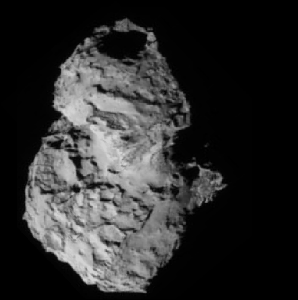 -
- 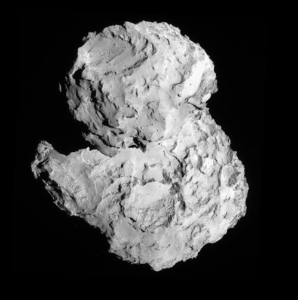
From side and bottom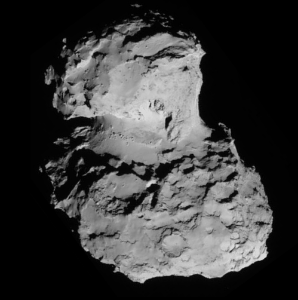
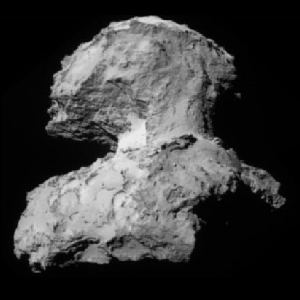
Posted by: belleraphon1 Aug 25 2014, 01:11 PM
Rosetta: Landing site search narrows - just posted on ESA blog
http://www.esa.int/Our_Activities/Space_Science/Rosetta/Rosetta_Landing_site_search_narrows
Craig
Posted by: Gerald Aug 25 2014, 02:53 PM
Philae candidate landing sites, synopsis:
http://imgur.com/UuPtltP
Posted by: charborob Aug 25 2014, 05:19 PM
Landing site A would probably have the most spectacular views: towards the "Neck" and part of the "Head".
Posted by: Y Bar Ranch Aug 25 2014, 06:10 PM
I was wondering how much of an upward look the cameras on board have. Couldn't find out exactly.
Posted by: charborob Aug 25 2014, 07:54 PM
Some discussion of this topic happened around posts 62-64 of this thread. Here is a https://www.youtube.com/watch?v=k1IFU6kxcD8 to a YouTube video.
Posted by: fredk Aug 25 2014, 07:58 PM
Each CIVA-P camera on Philae has a 60 degree fov. Most are tilted down by 15 degrees, but the stereo pair by 25 degrees. Of course the view will depend on the tilt of the lander once down.
Posted by: elakdawalla Aug 25 2014, 08:05 PM
Something I put together for a post tomorrow -- trying to look at the sites as seen in every NavCam image. Not totally sure about my identification of sites I and J in several places; there aren't very good landmarks for those.
http://planetary.s3.amazonaws.com/assets/images/9-small-bodies/2014/20140825_navcam-images-survey-scale5m_labeled.png
http://planetary.s3.amazonaws.com/assets/images/9-small-bodies/2014/20140825_navcam-images-survey-scale5m.png
Also, here's another view on the sites mapped on a shape model http://smsc.cnes.fr/ROSETTA/Fr/GP_actualites.htm.
http://planetary.s3.amazonaws.com/assets/images/9-small-bodies/2014/20140825_sites_atterrissage.png
Posted by: machi Aug 25 2014, 08:52 PM
CIVA can theoretically image features up to 18.5 degrees above horizontal plane which is defined by three points where landing gear touches the surface.
Lower limit is 48.5 degrees. Nominal limits for imaging are +15/-45° or +5/-55° (for stereo camera).
Slight (+/-3.5°) extension is possible by usage of tilting mechanism of lander himself but I don't suppose that this will be case in first scientific sequence (FSS, ~65 hours).
Posted by: lunaitesrock Aug 25 2014, 10:56 PM
I'm not sure what to make of the straitions in landing site A. They seem to be everywhere, especially in the cropped image below. The spacing is close to the same.
Posted by: vjkane Aug 26 2014, 12:41 AM
Site A gets my vote for the same reason. Let's hope the scientific and engineering analysis comes out to the same conclusion
Posted by: nprev Aug 26 2014, 12:49 AM
Pure speculation: The striations are artifacts of the comet's accretion in a primarily gaseous/aerosol-rich, warm primordial cloud. Perhaps the regular spacing is due to the thermal properties of the material: once a uniform layer cooled & solidified, a new layer began to accrete.
On the pessimistic side, could they be image processing artifacts of some sort?
In any case, fascinating as always to see the unknown slowly revealed. ![]()
Posted by: JohnVV Aug 26 2014, 01:49 AM
The striations at "A" look to be more like "land slide " groves 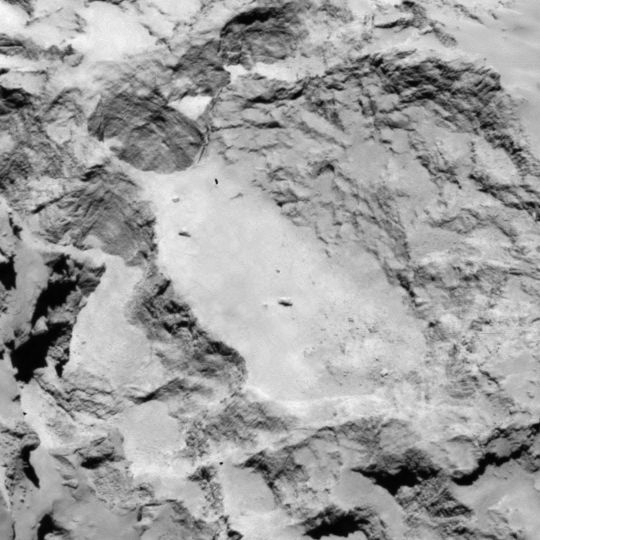
put it this way
The whole body is basically one BIG glacier ( with rocks )
as some of it slides the harder rocky bits will carve out grooves
http://en.wikipedia.org/wiki/Glacial_striation
Posted by: SteveM Aug 26 2014, 08:53 AM
as some of it slides the harder rocky bits will carve out grooves
Unlikely. A major factor in glacial striations is the weight (not the mass) of the glacier. On a comet gravity – and weight – are insufficient for a "glacier" to carve out grooves in rock.
Steve M
Posted by: SpaceScout Aug 26 2014, 11:39 AM
To this I would add that "landslide"/mass movement tends to move material to a lower gravitationally potential. The identification of mass wasting features is intuitive on large spherical bodies, e.g., on Mars a topographically lower material has a gravitationally lower potential. On this comet, however, one first needs to have an idea of the gravity field. A local topographic low does not necessarily have a lower gravitational potential.
So I would say that mass wasting identification can be tricky on this comet.
Striations might have a primordial origin or be formed by shock during impact on a former parent body. A plane analysis of the striations and a plot of the planes's pole would help to elucidate this.
Cheers
Posted by: Gerald Aug 26 2014, 01:36 PM
...
http://i.imgur.com/9Rr2B2q.jpg's my as-independent-as-possible result, based on your unlabled version.
I've been a little less successful with the A's and C's, but my positive identifications are consistent with yours.
Posted by: Gerald Aug 26 2014, 03:04 PM
I would agree, if we would know, that it's actually solid rock.
But if it's like fresh snow or loosely adhering dust, it's less easy to rule out erosion, e.g. by dust avalanches, as a cause.
If we presume the mean density as between 0.3 and 0.4 of that of water (three times the "old" estimate of 0.1 due to the triple mass), and water ice and silicate dust as main constituents, the mean porosity of the nucleus should be about 70%. This would rule out abundant massive solid rock, instead allow loosely connected non-spherical grains (e.g. flakes or needles), a solid foam (of rock and ice), lots of large caverns, kind of a dry aerogel, or some mix of these structures.
Posted by: MarsInMyLifetime Aug 26 2014, 06:26 PM
I am pleased to see site A on the list of candidate landing sites--not just because of the epic view across the valley but because of the adjacent deep hole (almost at north pole) that I suspect looks fresh because it may be one of the most active deep vents. If that is the case, imagine what that might look like as the venting process gets under way again. Also, I suspect that cliffs with piles of rubble at the base may also be active regions of venting, wasting from the face and leaving larger debris as the face recedes. In that regard, most of the proposed sites seem to have some potential active areas directly in view.
Posted by: Explorer1 Aug 26 2014, 10:20 PM
I suppose it goes without saying that marking a traditional 'landing ellipse' can't be done in narrowing down sites here, does it? Since all the targeting is done by the forces on release from Rosetta and local gravity (which is still unknown), and there is no propulsion on board Philae, it's going to be just as dicey as Huygens was.
Posted by: djellison Aug 26 2014, 10:43 PM
What I'm seeing in ESA's drawings is exactly that - landing ellipses. There is uncertainty in deployment velocity and gravity field ( which is being characterized as we speak )
The Huygens landing site was picked via engineering. The Philae site is being selected via a combination of engineering AND scientific goals and they will be targeting a specific location on the surface to aim for.
Posted by: marsbug Aug 27 2014, 06:15 AM
But if it's like fresh snow or loosely adhering dust, it's less easy to rule out erosion, e.g. by dust avalanches, as a cause.
If we presume the mean density as between 0.3 and 0.4 of that of water (three times the "old" estimate of 0.1 due to the triple mass), and water ice and silicate dust as main constituents, the mean porosity of the nucleus should be about 70%. This would rule out abundant massive solid rock, instead allow loosely connected non-spherical grains (e.g. flakes or needles), a solid foam (of rock and ice), lots of large caverns, kind of a dry aerogel, or some mix of these structures.
Depending on how evolved the comet is, and how it has evolved, the porosity may not be uniform. There may be volumes of far higher density, and near voids.
Posted by: fredk Aug 27 2014, 02:30 PM
Like Doug said there are (quantifiable) velocity and gravity field uncertainties, which have to translate into an uncertainty in landing position. One difference from landing on Mars is that an ellipse may not be a good approximation if those uncertainties are significant relative to the size of the comet. But you could always be conservative and enclose whatever the real shape is with a circumscribed ellipse. (Of course for a large enough region on such an oddly-shaped body it can be hard to define an ellipse.)
Posted by: lunaitesrock Aug 27 2014, 04:09 PM
Have there been any recent estimates on dimensions of a landing ellipses for any of the 5 sites? I haven't seen any except that they would cover 1 square km, which would include very risky terrain in each landing site as seen in the images. I have a hard time believing that landing ellipses won't eventually cover an area the size of a football field once more gravity field and shape data is obtained from lower orbits.
http://www.esa.int/Our_Activities/Space_Science/Rosetta/Rosetta_Landing_site_search_narrows
Also, will the Active Decent System and flywheel be used to actively aim the lander.... or just maintain orientation and velocity, with targeting to the touchdown point resulting only from the orientation and velocity of Philae at the moment of release from Rosetta? If it's the latter, it will be a heck of a ring toss!
Posted by: djellison Aug 27 2014, 04:15 PM
I have a hard time imagining it will ever be that small. That would require us knowing the location of the orbiter to an accurate barely wider than its own solar panels, and it's distance to the comet similarly accurately, AND the gravity gradiant all the way to the surface in a free-flight that might take anything from 2 to 12 hours. There is so much uncertainty there that a football field is far far too small an area to be thinking of.
The later. The lander has no means to do course-corrections on the way down. It's only propulsion is to 'stick' it to the surface during touchdown.
Posted by: elakdawalla Aug 27 2014, 04:47 PM
Regarding ellipse sizes: this image http://smsc.cnes.fr/ROSETTA/Fr/GP_actualites.htm shows "ellipses" that are diverse and irregular in shape, so I have been assuming that they are not just one-kilometer dots dropped onto the comet but actually contain some information about the likelihood of Philae landing within them. Notice how elongated the Site A one is, for instance. The open-ended shape of the Site I ellipse is puzzling.
http://planetary.s3.amazonaws.com/assets/images/9-small-bodies/2014/20140825_sites_atterrissage.png
Posted by: Floyd Aug 27 2014, 05:01 PM
I thought these were simply five SITES to further evaluate for which is the best SITE. Quite possibly ellipses are just crude SITE markings and not landing ellipses.
Posted by: climber Aug 27 2014, 05:47 PM
Emily, on your blog you rise the question regarding site A, whether a polar landing would be better than in a smaller latitude. I red that they want to use the comet rotation velocity to get the touch down as soft as possible. Well, A is still on the list anyway...
Posted by: Y Bar Ranch Aug 27 2014, 06:18 PM
http://planetary.s3.amazonaws.com/assets/images/9-small-bodies/2014/20140825_sites_atterrissage.png
Where would the axis of rotation be in this figure?
Posted by: Phil Stooke Aug 27 2014, 07:05 PM
I agree with Floyd's post - these should not be considered landing ellipses in the usual sense (envelopes of 50% or 99% dispersion around the target point) but just outlines of candidate areas which might contain the eventual landing site. The detailed studies (doubtless already well under way) of geology, approach paths, topography and gravity will eventually result in real landing ellipses, but we are quite a way from that at the moment.
The rotation pole is in the vicinity of site A.
Phil
Posted by: Explorer1 Aug 27 2014, 11:28 PM
In some combination of good/bad news, the navcam images are now filling the frame; they are compensating with four at a time, but only a 'corner' is out now:
http://blogs.esa.int/rosetta/2014/08/27/cometwatch-update/
Posted by: JohnVV Aug 28 2014, 12:34 AM
a image ( same as above )
with northpole and 180 Deg Long.
http://imgbox.com/Oarc8INQ
Posted by: Steve G Aug 28 2014, 04:33 AM
http://blogs.esa.int/rosetta/2014/08/27/cometwatch-update/
This comet really reminds me of that 1950's artwork of the moon and asteroids. It's downright creepy. Look at the pointed peaks and has a lot of variety for such a tiny world.
Posted by: Malmer Aug 28 2014, 07:34 AM
http://blogs.esa.int/rosetta/2014/08/27/cometwatch-update/
I have reverse engineered the camera location in relation to the comet for all the nav cam images from the begining of the encounter up until today.
I'm planning on doing it for all the images they release. (working on a shapemodel)
This would help when stitching images taken at slightly different times...
Is this archive showing all publicly available images? http://www.esa.int/spaceinimages/Missions/Rosetta/(class)/image)
Posted by: Malmer Aug 28 2014, 09:04 AM
One curious thing that I noticed is that ALL the navcam images released so far are clustered within one hemisphere of the comet.
Posted by: Hungry4info Aug 28 2014, 11:23 AM
The rotation axis is highly inclined like Uranus. Right now, one of the comet's poles are facing the sun, and the southern hemisphere is mostly in "night."
So, as far as being able to see things is concerned, it's only worth seeing the illuminated, northern hemisphere.
Posted by: MahFL Aug 28 2014, 12:07 PM
In your opinion which part of that is bad news ?
Posted by: centsworth_II Aug 28 2014, 12:51 PM
Posted by: fredk Aug 28 2014, 02:39 PM
What are the axes, and what are the orange blocks and coloured symbols here?
Posted by: Malmer Aug 28 2014, 02:59 PM
So, as far as being able to see things is concerned, it's only worth seeing the illuminated, northern hemisphere.
It would be nice with a "crescent" one just for aestetic purposes.
Posted by: Gerald Aug 28 2014, 03:06 PM
The orange blocks are symbols of the camera positions when the images have been taken.
The object in the center should reperesent the comet.
The quaternions together with the names/dates of the images would may be useful for people working on the same topic.
Posted by: Malmer Aug 28 2014, 03:09 PM
that little jumble of blue dots in the middle is the comet. The orange blocks represent the camera positions in relation to the comet for each shot.
The axes and scene scale are arbitrarily selected right now.
Posted by: Explorer1 Aug 28 2014, 05:46 PM
Yes, centsworth, that's what I meant by 'bad' news; we can't see the whole nucleus in the daily image release anymore. We haven't gotten an OSIRIS in a while either...
Posted by: MarsInMyLifetime Aug 28 2014, 06:29 PM
Were the landing site subframes based on OSIRIS or Navcam data? I supposed them to be peeks into the most recent OSIRIS planning photos.
Posted by: Hungry4info Aug 28 2014, 10:33 PM
The reason we haven't seen any of those is simply because Rosetta has not been on that side of the comet. We've stayed over the dayside for surveying purposes.
See this video.
https://www.youtube.com/watch?v=hplkIritIn8
Posted by: elakdawalla Aug 29 2014, 01:12 AM
Yes, the landing site "zooms" were eeny weeny crops of OSIRIS data, 540 pixels square out of the 2048-pixel CCD.
Posted by: bobik Aug 29 2014, 05:56 AM
What's funny (or even ridiculous) is the apparently deliberate pixellation of the http://www.esa.int/spaceinimages/Images/2014/08/Philae_candidate_landing_sites.
Posted by: Gerald Aug 29 2014, 12:28 PM
My interpretation of the pixelation has been the resizing of an image, which has previously been composed of reduced images, to the 540pixels/km scale.
Large images are simply more difficult to work with. The idea of rescaling may have emerged after the image has been prepared, and the post needed to be released.
Posted by: MahFL Aug 29 2014, 12:29 PM
Did ESA not already say some info will be withheld due to the scientists rights to the info to make their discoveries. ESA has it's own and different release policy from NASA/JPL.
Posted by: 4throck Aug 29 2014, 02:57 PM
Quite natural if you are making a 300dpi image for a press release, composed of individual lower resolution images.
Posted by: climber Aug 30 2014, 08:38 AM
I'm wondering whether they'll set up a live landing show for Philae like for Huygens?Anyone heard about this?
Posted by: vikingmars Aug 30 2014, 11:11 AM
Yes : affirmative. I'm working on it as TPS with Societe Astronomique de France and Ciel & Espace magazine for a huge show we are organizing with ESA for France to give a live coverage of the landing to a large audience. It will be very much organized like the live show we set up with ESA for the Huygens landing on Titan in 2005
Posted by: nprev Aug 30 2014, 06:35 PM
VM, will there also be a webcast accessible to international viewers?
Posted by: vikingmars Aug 31 2014, 11:22 PM
Yes : I think there will be an event in Darmstadt that will be broadcasted on TV.
But I dont't know about similar general audience events like the one we are setting-up in France.
Posted by: SteveM Sep 1 2014, 03:37 PM
http://blogs.esa.int/rosetta/2014/09/01/make-a-navcam-mosaic/ to make a Mosaic from Rosetta's four NAVCAM images. Here's my try using Hugin.
Image ESA/Rosetta/NAVCAM/Steve M
Posted by: machi Sep 1 2014, 03:57 PM
Here is my version rotated by 180° and resampled to 5 meters per pixel (close to real resolution ~5.2 m/pix).
Posted by: JohnVV Sep 1 2014, 06:28 PM
easy enough using Nip2 and a few tie points
http://imgbox.com/UlGIxwQ0
now do to camera rotation each image has about 5 extra pixels at the center corner ( the area that is vignetted )
Posted by: jasedm Sep 1 2014, 06:46 PM
Oh that's just astonishing! Great work guys. What an amazing piece of debris this is.
(Hugely speculative, and based on a few images):
It looks like two planetesimals of dense material have come together during the early stages of the solar system to form a contact binary, planetary migration then scattered them to a location where they accreted a few tens of metres of ice across the pair as a coating. A chance gravitational encounter then flung them into an elliptical sunwards orbit, with the ice being progressively sublimed away with each perihelion passage, partially revealing the denser and darker two bodies beneath.
Hey, I can hand-wave with the best of them....... ![]()
Posted by: MarsInMyLifetime Sep 1 2014, 11:43 PM
I'll have a try at it as well. The scree that lies on the large body side of the neck appears to fill in some pre-existing but no longer active sublimation pans (craters, if you will, but they are too close and consistent in size to convince me that they were formed that non-randomly). Sides of the large body also appear to be sloughed off at some more recent time in the comet's history. Given the neck appears to be the most active area the moment, my hand wave is that a larger original body became very thin in the middle and the "head" simply rolled back to a more gravitationally stable location against its larger part, where many years of continued wasting from the scar have laid the talus slopes inside the neck. It's all hand-waving until the scientists give us their interpretation, but for me this hypothesis avoids dealing with collision energies for low-strength objects. Back to more plausible fiction now...
Posted by: Gerald Sep 2 2014, 12:38 PM
There is scheduled an "https://plus.google.com/events/c9gb2sk457gharo9tr2m85bsnng" in a little more than an hour (16h CEST, 7 a.m. PDT).
Posted by: Y Bar Ranch Sep 2 2014, 01:00 PM
I'll take a shot...I think I'm in this camp. My theory is comet shrinking is an unstable process in that once the object departs from spherical to something more ellipsoidal, there is a trajectory of slighter lower energy to depart from the comet at the midpoint/minor axis and so that's where more erosion occurs. Stuff that doesn't depart accretes on the remaining lobes. If one lobe is bigger than the other, it steals from the smaller.
It would be fun and fascinating to run a simulation of this sort of thing. I imagine someone someplace is already doing it.
Posted by: ngunn Sep 2 2014, 05:16 PM
You made that statement before, but the opposite is in fact the case. The midpoint is the place on the comet's surface where gravitational potential is lowest, therefore material there requires more energy to escape than surface materials at other locations. Escape velocity depends only on the potential at a given point, not on the local value of the field strength. Saltating material (stuff that doesn't depart) would tend to migrate toward the neck, not away from it. The neck should act as a dust trap whilst the comet is far from the Sun and relatively inactive.
Once activity starts, however, my guess is that the ejection processes easily overcome the comet's weak gravity - irrespective of position on the comet. There are all sorts of possible reasons why the neck might be an active location - different material, looser packing, differences in insolation (was it a cold trap for volatiles at some point?), release of gravitational energy due to mutual settling of the two lobes, etc. etc.
Posted by: Mercure Sep 2 2014, 10:31 PM
It would be interesting to see a map of where "down" is in the different surface areas of the comet. A temporary one could be made by just using the 3D model and supposing homogenous density. If ESA at a later stage manages to identify mass concentrations the map could be refined.
Posted by: neo56 Sep 3 2014, 08:04 AM
I made an animation with the two OSIRIS pictures taken on August 7 using MorphX for Mac, to give a sensation of depth:
https://www.flickr.com/photos/105035663@N07/14939113547/
And here is my take on the stitching of NAVCAM pictures of August 31:
https://flic.kr/p/oL8wsu
Posted by: machi Sep 4 2014, 01:56 PM
The awakening of the comet 67P!
http://blogs.esa.int/rosetta/2014/09/04/cometwatch-2-september/ from NavCam clearly shows jets from the neck:
Credit for original images: ESA/Rosetta/NavCam.
Posted by: lunaitesrock Sep 4 2014, 02:51 PM
http://blogs.esa.int/rosetta/2014/09/04/cometwatch-2-september/ from NavCam clearly shows jets from the neck:
Credit for original images: ESA/Rosetta/NavCam.
The 2 jets seem very focused and appear to emanate from the bright clean face in the center of this image cropped from the Aug 7 ORISIS image.
The earlier overexposed NavCam image also shows multiple focused jets.
It doesn't seem like a relatively flat surface would give jets like these...
Wouldn't any 'jets' be broader (hemispherical) and more diffuse as the sublimation occurs and the expanding gas/dust leaves the 'flat' surface? I don't see anything in this suspected source area other than flat faces with little debris and no pits of any significant size.
It appears that as the volatile surface material sublimes, nonvolatile material accumulates at the bottom of the slope(s). The only thing I can figure is that a cover of debris heats up and the volatilized material escapes through a narrow opening to give the observed jets.
Perhaps someone will be able to narrow down the source of the jets on the surface from this and possibly other contrast enhanced images.
Posted by: Phil Stooke Sep 4 2014, 03:06 PM
The question of how jets become collimated like this has vexed comet scientists for a long time. One suggestion - I think from J. Crifo, is that the volatiles come from several sources near each other, and the dusty component is caught where the expanding gas cones intersect. Two sources would focus dust into a sheet where the two cones intersect, but three would focus it into a jet, and multiple gas sources would create multiple jets between triads of gas cones.
I don't know if that can work here but it's an interesting idea.
Phil
Posted by: fredk Sep 4 2014, 03:28 PM
One question I have is: does this jet come from the part of the neck visible in this navcam frame, or does it come from a part of the neck just "over the horizon" and hence not directly visible. In the latter case the direction of the jet would have a component away from us.
But I think we can rule the latter possibility out, since enhancement appears to show the jet in front of the overhanging portion of the smaller comet lobe:
In the area I circled, the jet appears to be visible against the shadowed portion of the overhang.
Therefore (unless I've got the overall lobe geometry horribly wrong) the jet appears to have a component towards us, and that should mean that the region of emission on the neck is indeed visible in the same navcam frame. One loophole might be that the jet is emitted close to horizontally from the surface. I don't know how likely that would be. But this should give us better confidence in locating the source.
Posted by: SpaceScout Sep 4 2014, 05:48 PM
I agree that the emission region seems to be visible in that navcam frame, or is at least close to the horizon. I'll try with this (very) tentative location. I have also broadly located the region in the 8 August frame.
The emission region might be related to the flat area of the neck, but not exactly where the "boulders"/spurs outcrop from the "dusty" surface. Or am I going too far with the interpretation?
Posted by: elakdawalla Sep 4 2014, 08:44 PM
http://www.unmannedspaceflight.com/index.php?showtopic=7883 (Still working on moving a few more posts...)
EDIT: Done. There were two almost completely independent discussions happening here, and I wanted the 3D modeling one to be able to continue seamlessly after this thread ends with the beginning of the next mission phase.
Posted by: jgoldader Sep 5 2014, 12:40 AM
The emission region might be related to the flat area of the neck, but not exactly where the "boulders"/spurs outcrop from the "dusty" surface. Or am I going too far with the interpretation?
Very nice image! What I'd like to know is, are we seeing an entirely undifferentiated body that's primarily eroding in the middle, or could perhaps the comet be a small piece of a larger, partially differentiated parent body, and better described as having an eroding, volatile-rich region in the middle that was sort of cementing together two chunks of more refractory material (the lobes). If the latter is the case, it might help explain the "dead comets," like (3200) Phaeton. Hopefully we'll find out!
Posted by: walfy Sep 5 2014, 01:12 AM
Landing site A may be even a greater place for a view, with source of streaming jets just below. Though a direct view to the very bottom of the "neck" might be had only in select locations from that perch. From Doug's excellent rendering:
Posted by: ngunn Sep 5 2014, 10:56 AM
Might not be such a good place once activity increases further, especially if the eroding neck breaks at perihelion.
Posted by: Floyd Sep 5 2014, 01:37 PM
If C-G breaks up it would be a bumpy ride regardless of where the probe lands--might as well get crushed rather than flung from the surface...
Posted by: elakdawalla Sep 5 2014, 03:02 PM
![]() What's the name of the comedian?
What's the name of the comedian?
Posted by: Gerald Sep 5 2014, 04:36 PM
The closest I could get with this annotated stereo
is: very close to the horizon.
The lines try to connect the peaks of the grey levels in each of the two images.
Posted by: wildespace Sep 5 2014, 04:41 PM
I see two separate jets, originating from slightly different locations and pointed in different directions. They criss-cross in this image:
Posted by: neo56 Sep 5 2014, 06:22 PM
I adjusted the levels to highlight the jets, then superposed the normal image with 50% opacity. It seems there is another jet on the right of the neck. But I checked on the individual NavCam images and when I adjust the levels, the jet is not here... So it may only be an artefact from the stitching process.
https://flic.kr/p/p5qDnv
Posted by: MoreInput Sep 5 2014, 06:39 PM
"Might not be such a good place once activity increases further, especially if the eroding neck breaks at perihelion."
@ngunn: Maybe that would be the best place ever in history of watching comets. The ESA could then make a new movie blockbuster "Armageddon 2: Breaking comet".
I really hope that there will be a major break up.
Posted by: marsbug Sep 5 2014, 07:09 PM
Great image. I think I can see a suggestion of a third jet on the left of the neck? To me it looks as though the lines of the jets lie something like in the attached image. It's not at all clear to me what angle the jets are relative to the local surface, or that they lie in the same plane, so I couldn't say where any originated except somewhere along their centre lines.
Posted by: Lewis007 Sep 6 2014, 08:15 AM
Early results from the Alice instrument:
http://www.jpl.nasa.gov/news/news.php?release=2014-297
Posted by: Gerald Sep 6 2014, 02:19 PM
I'm wondering about the chemical composition and the microscopic structure of the surface. The very low albedo in the far uv as well as in visible light makes me thinking of http://en.wikipedia.org/wiki/Soot or other large organic molecules (carbon-rich http://en.wikipedia.org/wiki/Tholin, http://en.wikipedia.org/wiki/Asphalt, http://en.wikipedia.org/wiki/Polycyclic_aromatic_hydrocarbons).
A very rough surface on the micrometer and nanoscale might also be able to explain the very low albedo on a wide range of wavelengths (far uv, and visible).
Posted by: scalbers Sep 7 2014, 07:56 PM
In terms of the Alice results, does this mean the neck wouldn't have at least a slightly higher albedo and some exposed water ice?
Posted by: walfy Sep 8 2014, 05:16 AM
This talk from San Francisco's Exploratorium gives a great rundown of the comet, the craft, the mission so far, with nice illustrations and demonstrations:
http://www.youtube.com/watch?v=lBSwyIdxJoA&list=UUR4I4iSvzltLN_WumwIBC3Q
Posted by: Phil Stooke Sep 8 2014, 03:12 PM
Land on THAT!!! (or perish in the attempt)
http://www.esa.int/spaceinimages/Images/2014/09/Comet_on_5_September_2014
Phil
Posted by: MahFL Sep 8 2014, 04:17 PM
http://www.esa.int/spaceinimages/Images/2014/09/Comet_on_5_September_2014
Phil
It's hard to remember that the comet does not have 1g of gravity, any second would expect rocks to tumble.
Posted by: Gerald Sep 8 2014, 04:33 PM
The http://blogs.esa.int/rosetta/2014/09/08/virtis-maps-comet-hot-spots/ seem to point towards a carbon-rich, dry, and porous/dusty surface, as one could anticipate from the preliminary Alice results, too:
Posted by: MarsInMyLifetime Sep 8 2014, 05:11 PM
I am not convinced that all those "boulders" are conventional rocks. I did not expect to see so much rounded original material; many of these look like products of erosion or recomposition. By way of explanation for what I see, I don't expect erosion (except for the evidence of Mars-like "spider flows" where gases may have carved channels under the debris). But I don't discount accretion of volatile materials into new forms, either.
Edit to add that the image scale is still too small to really characterize the roughness of the rocky shapes. Let's hope for a closer view. I'll bet the scientists are just going nuts over the wealth of "never before described" data they are looking at.
Posted by: Malmer Sep 8 2014, 05:57 PM
http://www.esa.int/spaceinimages/Images/2014/09/Comet_on_5_September_2014
Phil
That image clearly shows just how amazing the OSIRIS camera really is!
I draped the image onto my work in progress shapemodel so that a synthetic stereo view could be derived:
http://mattias.malmer.nu/wp-content/uploads/2014/09/OSIRIS_sep_5_synthetic_anaglyph.jpg
Cant wait to see more real stereo stuff from OSIRIS.
Posted by: marsbug Sep 8 2014, 08:35 PM
Edit to add that the image scale is still too small to really characterize the roughness of the rocky shapes. Let's hope for a closer view. I'll bet the scientists are just going nuts over the wealth of "never before described" data they are looking at.
I see a few distinctly finger or knife edge like 'rocks', as well as more rounded shapes. I wonder if most of what we're looking at isn't the resut of aeons of hydrocarbon materials settling into shpaes due to internal stresses (and vapour flows) as their ice sublimates? WRT surface composition: If the surface material is porous, could a significant amount of ice be caught in those pores, in the near subsurface?
And generally WOW.....
Edit: I didn't see this posted further up the thread: http://www.universetoday.com/114389/rosettas-cloudy-comet-shroud-spotted-from-the-ground-while-spacecraft-picks-up-dust-grains/#more-114389
Posted by: The Singing Badger Sep 9 2014, 12:28 AM
This picture is amazing. To me, as a non-expert, the amazing thing is how earthlike it looks. It looks like a chunk of the Rocky Mountains floating in space. Am I wrong about this? Would any geologists be interested in explaining to a complete ignoramus what is 'alien' about this picture? Like, is there anything about the geology on display in this image that couldn't possibly exist on earth and gives it away as being obviously a photograph of a small asteroid or comet? I'd love to know.
Posted by: MarsInMyLifetime Sep 9 2014, 12:55 AM
I'm also trying to rationalize the appearances with my own experiences. The rocks we know--igneous and sedimentary rocks of Earth's mountain ranges--are the many-times-recycled grandchildren of the pristine meteor matter embedded in these ices. How about the "tree trunk fortress" on the upper right, or the uniquely thin spires and walls (which look like volcanic dikes but can't be--it's an ice world). The "cliff" seems to present a cutaway of the insides of the head, and I'm struck by the apparent spongy top layer which seems to be laced with flues at least partway down. Rocks that appear to be on a precipitous slope are simply revealing their local sense of where "down" is on this topsy turvy world. Overhangs covered with "drift" seem to have popped out little heaps of rocky material. It's as if mysterious forces have significantly modified this little dirty snowball, and it's truly mindblowing to finally get a close glimpse of things we've never seen before. Science will explain it all in dry PostScript proceedings in coming months, but I'm just gobsmacked, jaw-droppered, twitterpated and salivating at what I see. And those are proper terms most trained geologists are probably using as well right now.
Posted by: Lewis007 Sep 9 2014, 06:29 AM
The surface of comet 67P/Churyumov-Gerasimenko can be divided into several morphologically different regions, as shown by a map published by the Max Planck Institute.
http://www.mps.mpg.de/3788997/PM_2014_09_08_Eine_Karte_des_Rosetta-Kometen
Posted by: Gerald Sep 9 2014, 12:42 PM
The images are overexposed in some way.
If part of the comet would be placed somewhere into the Rocky Mountains, it would maybe collapse under its own weight due to its weakness, and end up in a large dust cloud, or some black smelling mud. Taking this aside, it would look pitch-black, much darker than (unweathered) http://en.wikipedia.org/wiki/Basalt. It would (probably) be almost as light as http://en.wikipedia.org/wiki/Pumice, at least lighter than water.
With a http://en.wikipedia.org/wiki/Carbonaceous_chondrite#CI_group, like http://www.lpi.usra.edu/meteor/get_original_photo.php?recno=5631376, you may get an idea of how the comet might be composed near the surface, under a possible black dust layer.
Posted by: Malmer Sep 9 2014, 01:14 PM
http://www.mps.mpg.de/3788997/PM_2014_09_08_Eine_Karte_des_Rosetta-Kometen
I did away with some of the colorization just to be able to see the image more as it was shot. Is there an untouched version out there?
http://mattias.malmer.nu/wp-content/uploads/2014/09/ESA_Rosetta_OSIRIS_no_map.jpg
Posted by: SpaceScout Sep 9 2014, 02:51 PM
I agree that some morphologies on the comet, e.g., shape of the "rocky" outcrops (with pinnacles, sets of fractures and blocky appearance) and adjacent smooth areas and boulders, are reminiscent of reliefs on Earth, e.g., wind eroded granit. Now, the rock type is completely different, perhaps, like Gerald suggested, the most similar rock on Earth is pumice (porous but with strength). My guess is that the similar morphologies derive from similar processes. On the latest OSIRIS image (center up) there is a field of boulders just at the foot of a wall with pinnacles, suggesting (to me) scarp retreat by rockfall. On 67P the retreat might be driven by ice sublimation. On Earth, scarp retreat can be due to physical weathering (changing temperature), wind, ect.
What is alien about it is that despite different gravity and temperature conditions, and despite different rock types (=completely different environment of rock formation) the resulting local-scale morphologies are surprisingly similar!
@Malmer. Great un-colored image: the “unit boundaries” can be better seen now. No, I haven´t found the original image neither.
Posted by: marsbug Sep 9 2014, 04:33 PM
I defer to superior knowledge....but the outlines of some of the surface features made me wonder if processes akin to those responsible for http://www.lifeoops.com/2013/10/25/most-bizzare-stuff-today/ (transport of materials by escaping gas) might be at work.
Posted by: neo56 Sep 9 2014, 04:57 PM
Thanks for your anaglyph Malmer, it's awesome!
Posted by: The Singing Badger Sep 10 2014, 03:04 PM
Thanks for all the answers to my question!
Posted by: anticitizen2 Sep 10 2014, 03:06 PM
It is more beautiful than I could have imagined
http://blogs.esa.int/rosetta/2014/09/10/rosetta-and-philae-snap-selfie-at-comet/
Posted by: Phil Stooke Sep 10 2014, 04:06 PM
Very nice! If you really stretch the view of the comet, the jets are revealed again.
Phil
Posted by: neo56 Sep 10 2014, 04:47 PM
Mosaic of NavCam pictures taken on 7 september:
https://flic.kr/p/oSEU7d
Posted by: walfy Sep 10 2014, 05:46 PM
Could that also be lens glare going on? The spacecraft itself is also causing similar glare near each bright spot.
Posted by: Phil Stooke Sep 10 2014, 06:02 PM
There is fuzziness elsewhere in that image which might be just glare, but this is right over the neck area, so I think this is jets.
Phil
Posted by: MarsInMyLifetime Sep 10 2014, 09:18 PM
Phil
Because several images were merged for admittedly pictorial impact, the data's integrity for interpretation is iffy to me. But man, what a pretty selfie!
Posted by: ngunn Sep 10 2014, 10:00 PM
These recent views, unlike earlier ones, are looking into the light. From this angle the jets should be more prominent relative to the cometary surface, similar to what we have seen in Cassini's images of Enceladus. So my bet is on Phil: that image does show the jets.
Posted by: MarsInMyLifetime Sep 11 2014, 04:49 AM
The latest ESA mosaic has a phenomenon that might be useful going forward: each adjacent pair happens to have enough overlap to yield a nice cross-eyed view of that section of landscape. In these views that I cropped and lined up (generally Sun coming from top or left for ease of visual sensemaking), the elevations of the platforms and furrows become much more clear, at least to me. Hoping this happenstance of the mosaic overlap is of use to somebody. In clockwise order:
Edit: A tap or two of Ctrl+ helps to get the scale up to where stereo merging is easier.
Posted by: Malmer Sep 11 2014, 08:51 AM
"edit removed images"
Edit: A tap or two of Ctrl+ helps to get the scale up to where stereo merging is easier.
Yes those mini stereo strips are really cool. It is a nice little extra perk. I eill try to make little mini 3D dem:s out of them. They make it easier to understand just how rough and hostie the surface really is. But I'm hoping that we get another osiris stereo pair at some point.
Posted by: marsbug Sep 11 2014, 10:11 AM
Edit: A tap or two of Ctrl+ helps to get the scale up to where stereo merging is easier.
Thanks MarsInMyLifetime! Looking at the steep sided, flat topped, mound just to the lower right of the center of the image I've left in the quote... can anyone say if the bright top the result of a lighter deposit, or angle wrt the Sun?
Posted by: vikingmars Sep 11 2014, 11:31 AM
Totally agree with you, Phil.
They are jets indeed, because they are oriented towards the Sun.
I made my own processing yesterday of the nucleus for some friends in France, haven't seen your post, and I obtained the same results...
Posted by: MarsInMyLifetime Sep 11 2014, 01:09 PM
That feature was exactly what got me to investigating the possible stereo effect. The shadow shows that it is projecting a rounded top onto the terrain, so it is definitely not at surface level (just a bright spot) or flat topped. It is boulder-like, unlike the rampart structures which are generally quite a bit larger. I'm looking forward to explanations why it and the series of smaller bright objects above it are not draped in the same dark stuff that covers the rest of the landscape.
The pan in the middle left has some interesting furrow features that look like fingers reaching into the circle. I'm starting to see these furrows/tubes in many places now. They may have something to do with the transport of volatiles to the surface (and then end up exposed as fossil features once their former substrate sublimates away).
Posted by: marsbug Sep 11 2014, 01:44 PM
I'm glad to hear you say that, I was thinking I was imagining things - there are linear features, and even sets of narrowly spaced parallel furrows, in the images I've seen. My guess would be gas transport to, but who knows (yet)? Fascinating!
Posted by: Harder Sep 11 2014, 08:01 PM
The science editor of a reputable Dutch newspaper reported today that the Philea landing site selection process is becoming tense, as the sheer roughness of the 67P surface is becoming increasingly evident at the candidate landing sites. There are flatter (less rough) areas on 67P but these are unfavorable for the required amount of sunlight for Philea. What will the landing team decide? I can’t wait to hear their decision and rationale on Monday!
Posted by: atomoid Sep 11 2014, 10:48 PM
(below left) interesting bright circular patch at top right in http://www.esa.int/spaceinimages/Images/2014/09/Comet_on_10_September_2014_NavCam.
Nice resolution in this release, also nice is the subtle illumination of the dark inner-facing 'side' between the two lobes.
the same area is covered on http://www.esa.int/spaceinimages/Images/2014/09/Comet_on_31_August_2014_NavCam_B http://www.esa.int/spaceinimages/Images/2014/08/Comet_on_16_August_a http://www.esa.int/spaceinimages/Images/2014/08/Comet_on_8_August_2014_-_NavCam http://www.esa.int/spaceinimages/Images/2014/08/Comet_on_3_August_2014, but the http://www.esa.int/spaceinimages/Images/2014/08/Comet_on_7_August_a has it (below right), seems theres nothing there, perhaps a sort of camera artifact?
Posted by: vikingmars Sep 12 2014, 09:24 AM
Here is the spectacular image taken by Rosetta's NavCam on September 10, showing the nucleus of comet 67P/Churyumov–Gerasimenko, and fully cleaned and processed to show you its backlighted shape. The night side of the front lobe is now seen thanks to the sunlight coming from the other lobe... Enjoy ! ![]()
Posted by: neo56 Sep 12 2014, 04:57 PM
Really impressive image Olivier !
Posted by: polaris Sep 12 2014, 05:42 PM
Impressionnant, Olivier !
La présentation pour La Villette avance ?
Posted by: SpaceListener Sep 12 2014, 08:23 PM
Recent update from ESA http://spaceref.com/comets/where-will-rosettas-philaes-lander-land-on-comet-67pchuryumov-gerasimenko.html
Posted by: Explorer1 Sep 13 2014, 04:30 PM
No matter what happens on touchdown, there will be loads of science data from Philae: http://blogs.esa.int/rosetta/2014/09/13/science-with-the-lander-what-to-expect-when-philae-meets-67p/
Looks like the surface temperature is the main limit on lander lifetime as perihelion approaches.
Posted by: MarsInMyLifetime Sep 13 2014, 05:09 PM
Yes, it's fascinating to look at each part of landscape from its own "local level" as it were. The closest terrain appears scoured to me, suggesting that some venting occurs laterally, perhaps out from underneath rocky layers. Considering the eons of activity on this world, I'm actually surprised there is not much more buildup or selective puddling of boulders on the surface. Do they get ejected regularly, or is it a case of actually very low populations of boulders that are too heavy to leave the gravity well?
Posted by: vikingmars Sep 13 2014, 06:57 PM
Thanks Polaris, Thanks Neo
Oui, ca avance bien mais Gilles doit faire un point très vite avec l'ESA, car la mission est gérée un peu aussi au "jour le jour". Le noyau est extremement cabossé à l'échelle du mètre de ce nous avons compris et meme sur les sites retenus l'atterrissage sera dangereux. En plus, ils n'ont aucune idée dans quoi va se ficher les grappins pour que la sonde s'aggrippe au noyau... En bref, c'est "chaud", plein de surprises et on est suspendus aux décisions. Du coup, je suis en retard sur ma presentation et Gilles aussi ! Je vous tiendrai au courant...
Posted by: PaulM Sep 14 2014, 07:41 AM
Oui, ca avance bien mais Gilles doit faire un point très vite avec l'ESA, car la mission est gérée un peu aussi au "jour le jour". Le noyau est extremement cabossé à l'échelle du mètre de ce nous avons compris et meme sur les sites retenus l'atterrissage sera dangereux. En plus, ils n'ont aucune idée dans quoi va se ficher les grappins pour que la sonde s'aggrippe au noyau... En bref, c'est "chaud", plein de surprises et on est suspendus aux décisions. Du coup, je suis en retard sur ma presentation et Gilles aussi ! Je vous tiendrai au courant...
Thanks Polaris , Thanks Neo
Yes, AC is progressing well but Gilles must make a point quickly with ESA, because the mission is managed a little as the " day to day " . The core is extremely dented across the meter that we understand and even to the selected sites will be dangerous landing . In addition , they have no idea what will file grapples for the probe aggrippe kernel ... In short , it is " hot" , full of surprises and is suspended from the decisions. So, I 'm late on my presentation and Gilles too! I 'll keep you posted ...
Posted by: Hungry4info Sep 15 2014, 08:17 AM
In about an hour, the landing site will be announced.
http://www.esa.int/Our_Activities/Space_Science/Rosetta/Watch_Rosetta_landing_site_selection_announcement
Edit:
Site J is the Primary site.
Site C is the secondary site.
If I understood right, they think they see some hints of activity from near the site, which they believe is associated with some of the cyllindrical pits we're seeing.
Edit2: new images of primary landing site.
http://www.esa.int/spaceinimages/Images/2014/09/Philae_s_primary_landing_site
http://www.esa.int/spaceinimages/Images/2014/09/Philae_s_primary_landing_site_close-up
And backup site.
http://www.esa.int/spaceinimages/Images/2014/09/Philae_s_backup_landing_site
Posted by: Malmer Sep 15 2014, 10:28 AM
Interesting that the landingsite 3D view looks like it is made using a digital elevation model with a picture draped over it.
The signal to noice ratio is just fabulous with the osiris camera!
Posted by: MahFL Sep 15 2014, 10:31 AM
How accurately can they target the lander ? I know it just floats down due to the comets gravity.
Posted by: MarsInMyLifetime Sep 15 2014, 12:46 PM
From http://www.esa.int/Our_Activities/Space_Science/Rosetta/J_marks_the_spot_for_Rosetta_s_lander:
"The descent to the comet is passive and it is only possible to predict that the landing point will place within a ‘landing ellipse’ typically a few hundred metres in size."
This is actually a quite good dispersion zone for this method of placement. Let's hope everything goes well with the release process and the calculations!
Posted by: Gerald Sep 15 2014, 01:08 PM
I don't think, that they really know the accuracy of the landing (at the moment). Roughly 1 square kilometer.
The actual landing position is highly sensitive to the velocity vector (amount and pointing) after separation of the lander. They first accelerate the orbiter roughly towards the nucleus onto a hyperbolic orbit, then separate Philae from Rosetta, and return to an elliptical orbit for Rosetta. Separation after accelaration towards the nucleus reduces the descent time, and the sensitivity of the trajectory regarding the field of gravity of the comet, and regarding the initial velocity vector after separation.
Neither the result of the first burn nor the momentum provided to Philae by the separation are known precisely.
There is some sensitivity to the mass of the nucleus. This mass cannot be determined exactly, since the orbit of Rosetta is influenced by the gravity as well as by gas emanated from the nucleus; this orbit is used to determine the mass and field of gravity of 67P/C-G.
There is some more subtle dependency of Philaes's trajectory from the detailed field of gravity of the nucleus.
Overview of the operations for landing (cropped screenshot of today's press conference) :
This is the area they are considering for site J to estimate the risk induced by slope (another screenshot):
Posted by: Ron Hobbs Sep 15 2014, 01:51 PM
... and the winner is ...
http://www.esa.int/Our_Activities/Space_Science/Rosetta/J_marks_the_spot_for_Rosetta_s_lander
Posted by: fredk Sep 15 2014, 03:06 PM
The http://www.esa.int/spaceinimages/Images/2014/09/Philae_s_primary_landing_site_in_3D says they used two images to make the anaglyph.
Posted by: Gerald Sep 15 2014, 03:43 PM
First, I thought, they would provide a complete recorded version of the press conference immediately after the conference. Seems not. So here some of the slides:
Edit: Quite some more background info about the selection process last week-end is described in http://www.cnes.fr/web/CNES-fr/11464-gp-le-choix-du-site-d-atterrissage-de-philae.php (in French).
Two things I didn't see elsewhere thus far have been, that Philae is expected to set on site J with 0.95 m/s, and site C won't be suitable for Consert.
Posted by: SpaceScout Sep 15 2014, 05:15 PM
here is the replay of today's landing site announcement:
http://www.esa.int/spaceinvideos/Videos/2014/09/Replay_Rosetta_landing_site_announcement
Posted by: Malmer Sep 15 2014, 05:27 PM
I made a detailed 3D model of the landingarea:
http://mattias.malmer.nu/wp-content/uploads/2014/09/trim.C1A54825-A846-4FDA-8FB0-B07C90EBCBD8.mov
You can play with the 3d model if you like. (3D print?) Here is the obj file:
http://classic.syndicate.se/image/space/Landingsitemodel.zip
Posted by: SpaceListener Sep 16 2014, 02:32 AM
Up to now, I still haven't see on what axis the comet rotates. This is an important matter for simplifying the landing operation and the illumination factor. By the way, http://www.jpl.nasa.gov/news/news.php?release=2014-310&utm_source=iContact&utm_medium=email&utm_campaign=NASAJPL&utm_content=daily20140915
Posted by: JohnVV Sep 16 2014, 04:27 AM
for the rotation see the thread that was split off this one
i have posted many images with the X axis as the axis of rotation
http://www.unmannedspaceflight.com/index.php?s=&showtopic=7883&view=findpost&p=212592
http://www.unmannedspaceflight.com/index.php?s=&showtopic=7883&view=findpost&p=212594
Powered by Invision Power Board (http://www.invisionboard.com)
© Invision Power Services (http://www.invisionpower.com)
